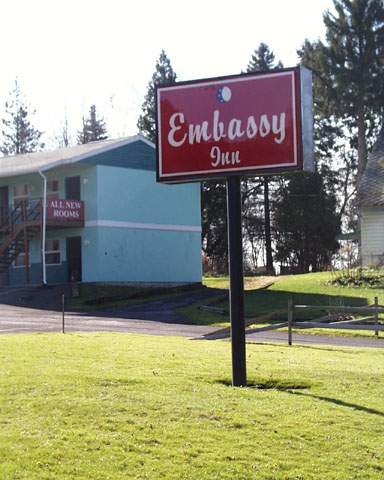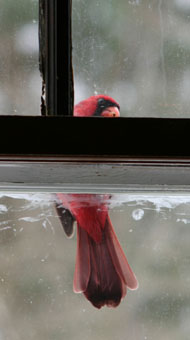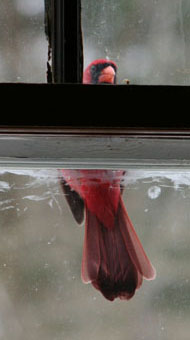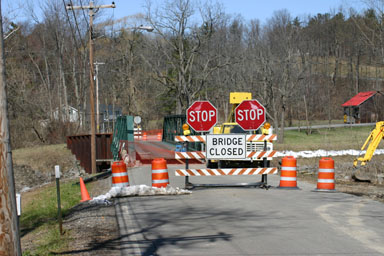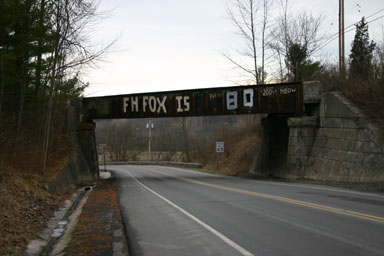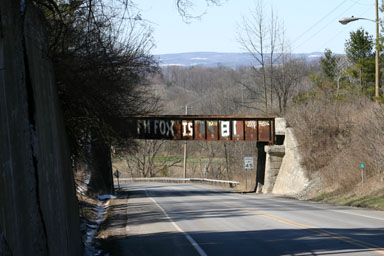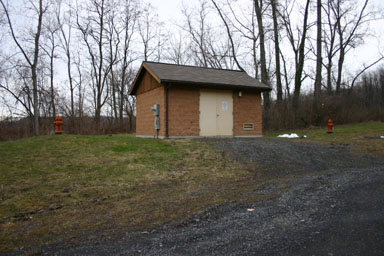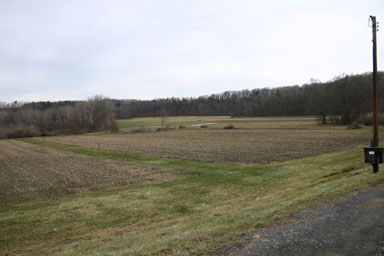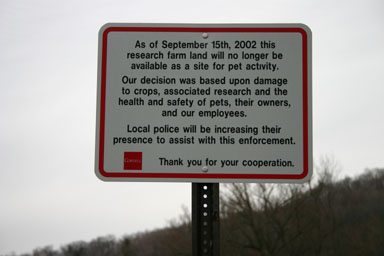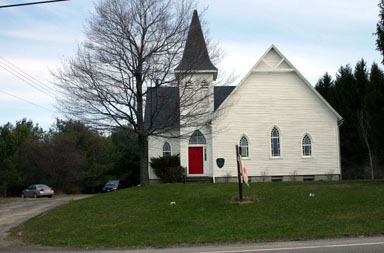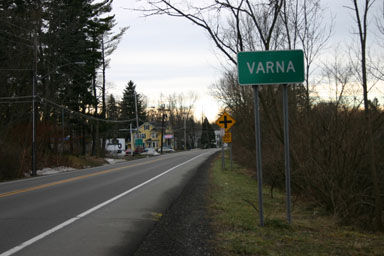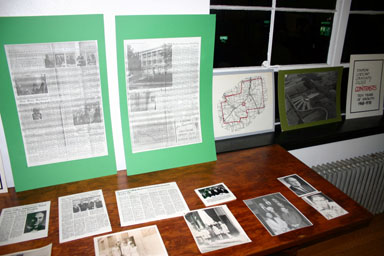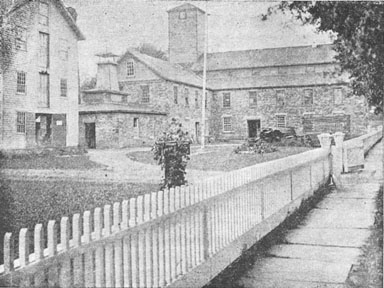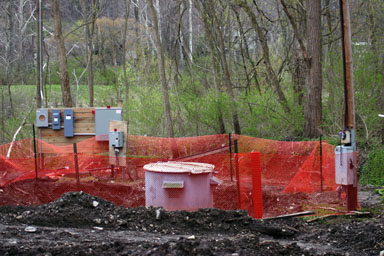April 1, 2004
Smart Growth can be profitable in many ways
Lynn Richards, Senior Policy Analyst at the EPA, gave a general presentation on Smart Growth last night, explaining how planning is changing to encourage the creation of landscapes which accomodate people - and not just cars - once again.
Smart Growth approaches focus on ten core principles, which are worth listing to give a broad idea of where this goes:
- Mix land uses.
- Take advantage of compact building design.
- Create a range of housing opportunities and choices.
- Create walkable communities.
- Foster distinctive, attractive communities with a strong sense of place.
- Preserve open space, farmland, natural beauty, and critical environmental areas.
- Strengthen and direct development toward existing communities.
- Provide a variety of transportation choices.
- Make development decisions predictable, fair, and cost-effective.
- Encourage community and stakeholder collaboration in development decisions.
It's not, of course, just principles, and they were handing out copies of Getting to Smart Growth II: 100 More Policies for Implementation, which had more detailed suggestions for how to implement each of the ten principles in ten different ways. (Volume I is also available, and there are a lot more resources available online as well.)
Richards started by noting that development trends look fairly ominous, as people are using more and more land per person while population forecasts show continuous growth - 50 million more people in the U.S. by 2020. She showed a map of developed areas between Baltimore and Washington at twenty-year intervals from 1900 to 2000, and the growth of development skyrockets after 1960.
The environmental consequences of this are well-documented: more emissions from cars driving more miles, watershed impacts and stormwater run-off issues, and ever-increasing pressure on natural habitats. This outward style of growth has also left behind brownfields, areas contaminated (or perceived to be contaminated) with chemicals, and grayfields - areas that are no longer used but which remain paved over. Richards mentioned a "dead mall study" at one point, and noted that 20% of malls are closed or just half-full. These areas are prime candidates for creative reuse.

EPA analyst Lynn Richards presents on Smart Growth
Richards also brought up busing, noting that "hazard busing", busing students to school because the school isn't safely accessible by foot, is increasing dramatically. The lack of pedestrian activity for children is also showing up in rising obesity rates, as the environments in which we live take a toll on us.
She spent some time examining what Smart Growth is and is not. She emphasized choice throughout her presentation, that consumer actually want a variety of different living environments, especially over their lifespan. Smart Growth focuses on "well-planned growth that improves the quality of life", and isn't about shutting down growth entirely.
Politically, Smart Growth is in an interesting place. Richards noted that because federal Smart Growth initiatives had begun under the Clinton administration, they were concerned that the Republicans would see it as a Democratic initiative and trim it. Instead, their budget has actually doubled under the Bush administration. She also noted that Republican California governor Arnold Schwarzenegger, along with many other Republican governors, supports Smart Growth approaches.
Economically, Smart Growth seems to work well - development projects built with Smart Growth principles sell out early and don't lose money for the developer. In a lot of ways, Smart Growth reduces risk for both the developer and the municipality while making consumers happier.
She also pointed out ways in which current zoning - separation of residential from commercial activities, setback requirements, and barring the classic apartments-above-a-store approach - actually keeps the free market from operating, and restricts the choices developers can offer consumers. Infrastructure policy and stormwater management law were other potential barriers where good intentions have produces some perverse results, especially when applied to reusing already developed areas.
Rehabilitating old buildings, something that has a lot of potential for areas with older housing stock (including Dryden) is also a key part of Smart Growth. Richards mentioned New Jersey's revision of its building codes to avoid the crippling requirement that an entire building be brought up to code when only a small part of it was being renovated.
Most of her examples were urban or suburban, notably Arlington, VA, Rochester, NY, Westchester County, NY, and Somerville, MA, though she noted that Cattaraugus County, NY was working on a plan that would maintain balance between urban and rural zones.
She discussed the EPA's role briefly, which seems primarily to be assisting communities and developers by providing information and analysis. In a lot of ways, Smart Growth depends on grass-roots support to make it go, so it wouldn't make sense for the EPA to dictate what communities should do.
Questions focused largely on how to get things started, and how to arrange partnerships that would bring more resources to projects. One questioner asked about how to encourage Smart Growth when property ownership is fragmented into smaller parcels and it's difficult to create a single plan, and Richards responded that incremental development, building with an eye to future related growth in an area, could work well.
David Weinstein, a member of the Dryden Planning Board, asked about resources for Smart Growth, particularly redevelopment money. Richards pointed him to Smart Growth America as a source of information, especially the Smart Growth Leadership Institute.
Weinstein also asked about the coordination issues around Smart Growth, noting that in New York planning is largely a town, city, and village project, not a regional one. He asked about the possible conflict between, say, developing a hamlet and projects in more downtown areas. Richards said that communication was key for making regional coordiation work, but acknowledged that it wasn't easy. She turned to "providing choice" as the answer to possible conflicts between municipalities, suggesting that "letting the free market do its work" was a possible answer, as different market segments would want different kinds of environments. She also pointed to Community Rules, a book on Smart Growth in New England, as a possible resource.
I asked a fairly disjointed question about how Smart Growth projects seem to expect that increased options and improved pedestrian access can keep traffic from being a problem, but that it doesn't seem to offer many answers to communities where a major road itself is causing the community problems, and can't readily be moved. She suggested bypasses and redistributing traffic, though I don't know if that is actually plausible given Tompkins County's landscapes.
Smart Growth makes a lot of sense to me, and promises to bring back the pedestrian-friendly environments that people typically find more comfortable. At the same time, it doesn't seem like a magic panacea for development issues. The basic principles feel sound, and I think to some extent they've informed the Dryden Draft Comprehensive Plan, but they clearly provide a foundation for communities to use in figuring out what they want, not a set of instant answers.
More on the two Charlie Harts
After last week's letter about the two Charlie Harts in Dryden, one of whom writes letters to the editor, the letter-writing Charlie Hart wrote in. He argues that what's on the Opinion Page should stay on the Opinion Page:
If someone is upset enough to call me at home because of my opinions they will really be upset when they hang up. It is only an opinion and if it bothers someone, they can respond in the forum in which they heard or read it. There is no need to take it outside the forum as it should be understood that what is printed on The Journal's Opinion Page in no way is intended to harm someone -- especially a family who had nothing to do with what was printed.
The Journal (or Hart) appears to have made a slight change, identifying his letters as being from Charlie Hart of the Village of Freeville rather than of the Town of Dryden, as he was identified in previous letters.
More on phosphorous, planning
As noted here previously, the Town of Dryden will be having a public hearing on the removal of phosphorous from the City of Ithaca's sewage treatment plant, which serves the Varna and Route 13 area sewer districts. Today's Ithaca Journal has an article on the City's approval of extra cost for the work and controversies in the contract.
The Town of Dryden's share (which will apply to the sewer districts, not the town in general) is 1.9% of $4.97 million, or, as the hearing notice states, no more than $98,505, up from a previously approved $81,477.
Further afield, there are also articles on the county's upcoming comprehensive plan and the questions about implementing a comprehensive plan in Danby that echo concerns heard in Dryden.
Fair Housing Month, Art, Etna Community Association
This week's issue of The Shopper includes an ad proclaiming April to be Fair Housing Month in the Village of Dryden, an ad from the Dryden Schools Art Department asking for public support in keeping art programs from getting cut in the current round of budgeting, and a notice of the Etna Community Association's annual meeting, which will be in Houtz Hall (map) on April 6th at 7pm.
Tech behind this site
I've had a few questions lately about how I create this site, and figure it's worth a brief explanation in case anyone else wants to do something like. All the ingredients are readily available.
The web site is hosted (along with the rest of simonstl.com at hesketh.net, a great company I found while I was living in Greensboro, NC - they're down the road in Raleigh. It shares a server with lots of other sites; while I'd love someday to have the flexibility that having and controlling a dedicated server offers, it's way beyond my price range.
The engine I use to manage the site is Movable Type, which provides a framework for creating entries and presenting and archiving them in a wide variety of different styles. It's not as flexible as I'd like, but it works well for now.
I type entries in by hand, with some cut-and-paste between entries for common features like photos and maps. I don't like HTML editors very much, and don't think you really need them for a site this simple. I write on both a Macintosh (15" iMac) and an IBM ThinkPad laptop running Windows.
The presentation details are handled by a set of CSS stylesheets derived from the one that came with Movable Type, plus a stylesheet switcher that lets people choose what size type they'd like.
I take most of the photos here on a Canon Digital Rebel, easily my favorite technology purchase of the last few years. It's a digital camera that takes interchangeable lenses and can use an external flash, which I need to get soon to make my pictures of meetings look less ghastly. If you've seen me out taking pictures, I also use a Gitzo Monotrek, which combines a walking stick with a monopod, using a Manfrotto 484RC2 quick-release head so I can take the camera off of it while walking. I occasionally borrow my wife's much smaller Pentax S4, and the early pictures of Varna houses were taken with a sadly defunct Olympus D-620L.
I edit and resize photos with Adobe Photoshop Elements, which came with the camera, and am starting to use Adobe Photoshop Album to keep track of them. I use WS-FTP to upload pictures to the site once they're ready.
April 2, 2004
Fishing down, local economy up
It doesn't sound like the opening day fishing was very good, but on the brighter side Elia Kacapyr finds that the Tompkins County economy improved slightly overall in February.
Near the Embassy Inn
Continuing down 366 from the last few houses pictured, we come to the Embassy Inn and the buildings near it.
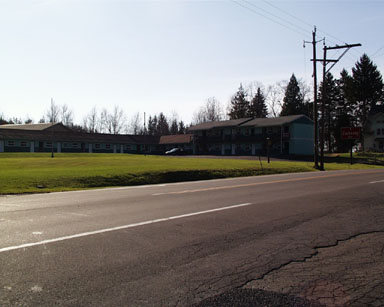
Embassy Inn, 1083 Dryden Road (map)
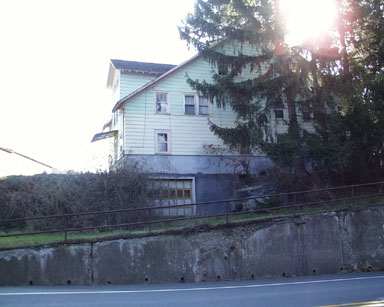
Unnumbered house next to Embassy Inn
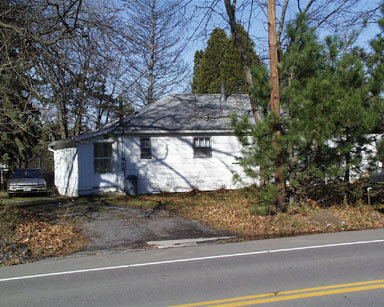
1082 Dryden Road (map)
If anyone knows the story of the unnumbered house next to the Embassy Inn, I'd be curious. It has a driveway, but it comes off the main driveway for the motel.
April 3, 2004
Memorial, lawsuit remind area of deaths
Today's Ithaca Journal has two stories which are reminders of very different but very sad moments in the Dryden area's history.
Members of communities surrounding Eglin Air Force Base, in Florida, have built a memorial and a road in memory of Patrick Griffin Jr., a graduate of Dryden High School who was killed in Iraq last year and is buried in Willow Glen Cemetery.
The Appellate Division of the Supreme Court reversed a verdict awarding $1.8 million to the family of Dryden teacher and coach Steve Starr for negligence by the Cortland County Sheriff's Department. The case revolved around the 1994 release of Jonathan Merchant on bail and his subsequent murder of Starr, despite the department's promise of protection.
Highway funding for Peruville Road
The highway funding bill that just passed in the House of Representatives includes $4.4 million for improvements to Peruville Road along the northern edge of Dryden (map), though much of that may also go to improvements further north in the Town and Village of Groton.
A few Dryden opinions
Today's Ithaca Journal editorial page continues a few Dryden-specific items:
- Betsy Darlington and the Finger Lakes Land Trust send a laurel to "Engineers without Frontiers" for building a footbridge in the Trust's Etna Preserve.
- Though cited as an Ithaca resident, Arthur Berkey of Ellis Hollow Road also sends a laurel to Cornell Fingerlakes Credit Union for funding scholarships.
- Ithaca Journal Managing Editor (and Town of Dryden resident) Bruce Estes spars with former Ithaca alderman Ed Hershey's take on the Journal's coverage of its own activities.
April 4, 2004
Introducing Dryden
I've had a few people (including some in the town) ask for more information about the town generally, in addition to the detailed information I'm providing in individual blog entries. This entry is intended to address those questions, and it will be updated on a regular basis whenever I get around to it.
The Town of Dryden has been on the map since the 1790s, when it was created as one of the townships in upstate New York's Military Tract, and named after poet John Dryden. Two hundred plus years later, it is a largely rural and suburban area between the cities of Ithaca and Cortland, and part of Tompkins County (map). It contains two villages, Dryden and Freeville, as well as a college, Tompkins-Cortland Community College (TC3), within its 94 square miles.
When it was originally surveyed, the town was drawn as nearly a square along the southern edge of the Military Tract. Seven of its hundred lots along the southern edge of the town were set off to Caroline in 1887, but otherwise the town has retained its largely square shape.
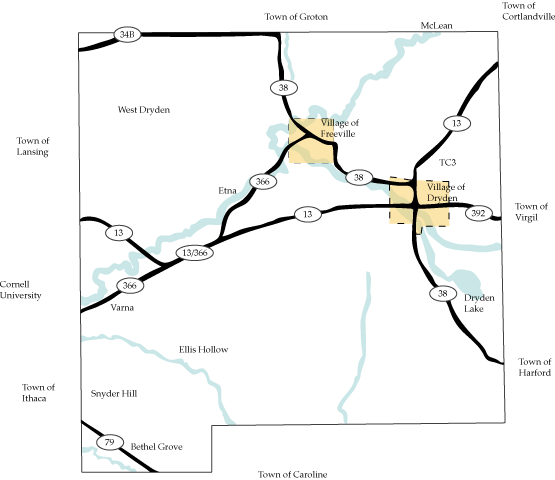
Town of Dryden map, showing state highways, villages, creeks, and lakes.
That shape straddles a number of divides, with forested hills in its southern reaches, part of the eroded Appalachian plateau, and more rolling terrain further north in the Great Lakes plains. The best farmland tends to be in the north and east of the town. Though there is scattered farming all over, many old Dryden farms which didn't have excellent soil are now state forest, privately held woods, or developed for other use. The entire area is loosely connected to both the Southern Tier region of New York and Syracuse. Dryden isn't far from the northern edge of the 607 area code, and the change in zip codes from 14 to 13 crosses the town. While most of the town is in the Great Lakes watershed, the southeast corner is in the Susquehanna River watershed.
The approximately 13,000 people living in Dryden are themselves divided in a number of ways. The hilly southern side of town tends to be in the Ithaca zip code and Ithaca City School District. To the north and east of the area where Routes 13 and 366 overlap are the Dryden Central School District, and the Etna, Dryden, McLean, and Freeville zip codes. Ithaca Journal newspaper boxes predominate in the southwest of the town, and Cortland Standard boxes in the northeast. The far southwest corner of the town, Bethel Grove, is also largely connected to Ithaca, but along a different state highway, Route 79.
Within the Town, there are two villages, Dryden (1,832 people in 2000) and Freeville (505 people in 2000). There are also several hamlets, which in New York means roughly "populated area without a municipal government of its own". Varna, along the western border with the Town of Ithaca, has about 679 people, while Etna, further north and east along Route 366, has about 379. The hamlet of McLean straddles the border with the Town of Groton in the northeast, and the Dryden side of it includes about 324 people. Other areas in the town with a distinct identity include Bethel Grove in the far southwest, Ellis Hollow to its north, and West Dryden in the northwest.
More on the hydrogen car
I mentioned Dryden High School seniors Sam Glidden and Jared Delahanty's hydrogen car project back in January, when the Ithaca Journal covered it. Now I've stumbled on their site covering the project, which has much more detail on the car and a great design as well.
Apartment complexes
The area between the Embassy Inn and the old Elmira, Cortland, & Northern railroad overpass is dominated by apartment complexes. The three complexes are very different, however.
The first, heading west to Varna, is Pineridge Residences, which I noted before in an earlier post. (It was completed last year.)
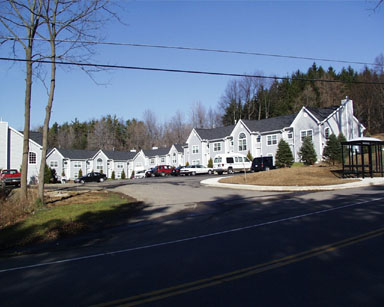
Pineridge Residences, 1060 Dryden Road (map)
The next two are older, though both very different from each other. Woodland Meadow Townhouses is a group of smaller buildings, while the DeBell Apartments are units in a building.
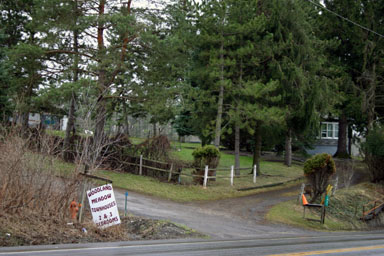
Woodland Meadow Townhouses, 1061 Dryden Road (map)
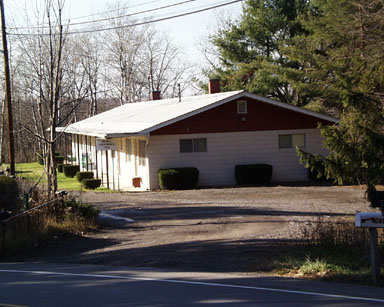
DeBell Apartments, 1056 Dryden Road (map)
April 5, 2004
Race for Congress heats up, deer
Today's Ithaca Journal reports on growing activity in the Democratic primary for the 24th Congressional District, which includes Dryden. Brian Goodell of Lansing is running against Jeff Miller of New Hartford, near Utica. Congressman Sherwood Boehlert, who currently holds the seat, is himself facing a primary challenge from Dr. David Walrath.
The Journal also examines a Cornell report on damage to New York agriculture by deer and proposals, including year-round hunting, for reducing their numbers.
Strange visitor
We had a problem last year with a cardinal that kept crashing into our livingroom windows. This year, he (if it's the same bird) seems to be using the windows as a perch instead. It's still loud, but he doesn't seem nearly as frustrated.
April 6, 2004
George Junior Republic talks encouraging
Today's Ithaca Journal reports that labor negotiations between SEIU Local 200 and George Junior Republic seem to be improving, as George Junior has backed down on its removal of family health care coverage from the contract. The negotiations and issues of state regulation of payments to George Junior were a big topic of conversation when Barbara Lifton held her forum in Dryden a few weeks ago.
The Journal also has a picture of a truck on Route 13 in Dryden going through yesterday's snow.
Bridge out
The detour signs on Hanshaw Road, Route 13, and Route 366 are up because of work being done on the bridge over Fall Creek on Freese Road in Varna. There's good reason for the detour.

Missing deck at Freese Road bridge
As noted earlier, work should continue for the next few weeks, through April 15th.
F.H. Fox was born in '23
Just past the apartment complexes, the old railroad bridge - Elmira Cortland & Northern, then Lehigh Valley - gets a slight modification every year in the spring.
Cornell veterinary students seem to be behind this annual revision of the grafitti, in honor of Francis Henry Fox, professor emeritus. They get both sides, too.
Full agenda for Thursday Town Board meeting
The agenda for Thursday's Dryden Town Board meeting includes six public hearings and a presentation of fire department awards as well as a long list of business.
The meeting will be Thursday, April 8, at 7pm at the Dryden Fire Hall (map).
April 7, 2004
Freeville taxes rising
Today's Ithaca Journal takes a close look at the costs driving a 10.8% tax levy increase in the Village of Freeville. Costs beyond their control - retirement, workers compensation, and their contracted police coverage from the Village of Dryden - are increasing. Questions about the state budget also make it harder for Freeville to plan its road work. (Update: That levy increase is accomplished through about a 3.6% tax rate increase, and the Journal has a correction on the story's first sentence.)
(In many ways, this echoes the Journal's editorial on school districts and costs.)
There's also a brief noting Teresa Carnrike's person of the year aware from Dryden Sertoma and Monday's Dryden Central School Board meeting, which will be at 7:15pm in the Dryden Elementary School cafeteria.
There's an article on the Dryden-based Tompkins County SPCA's battle with animal abuse.
The Community Business section profiles Wildflowers, a florist in the Village of Dryden.
The Family Fun section notes the Easter Egg Hunt in Montgomery Park on Saturday at 1pm, as well as the McLean Volunteer Fire Department's beginning its fund-raising drive.
The Neighbors section includes updates on the careers of two Dryden residents in the military, Navy Petty Officer 2nd Class Aaron D. Abb and USMC Lance Corporal Keegan G. Shields.
The print edition also contains tables on when houses were built in the Towns of Groton and Dryden. Very similar data, though broken into owner-occupied and renter-occupied, is available from the Census Bureau's American Fact Finder.
Mailbox Frogger
While putting some mail in my mailbox today, I got stuck on the far side of the road for about five minutes. There wasn't a huge volume of traffic, but both directions were steady. Fortunately it wasn't raining or terribly cold, but it did make me think again about the tremendous difference that having my mailbox on the other side of Route 366 makes to the way I see the road.
From my living room, the road is interesting to watch and annoying to listen to. I'm not entirely sure why the number of broken mufflers goes up every spring, but that seems to be the pattern. Insulating the house has reduced the noise a bit, though some windows still vibrate when vehicles producing certain kinds of noise go by, and my dog barks every time a UPS truck passes.
At the road, though, it's very different. Walking along the road is on the shoulder is unpleasant, but it seems more like the cars are intruding on my space than that I'm daring to intrude on their space. It's good to have a general idea of whether cars are staying in their lanes, but there's no need to calculate speeds and when precisely they'll pass you. Crossing the road means entering the cars' space, looking both ways and thinking hard about the speeds of cars and how long it will take them to reach my driveway. The passing lane adds even more complication.
Fortunately I used to play Frogger when I was a kid, though it's a little different when the cars are real.
Freeville government and teacher-parent communication
This week's Dryden Courier takes the recent uncontested elections as a good reason to take a close look at the Village of Freeville, how it operates, and what it provides to residents.
There's also a piece on Dryden Central School's ParentCONNECTxp program for connecting parents more directly to their children's performance through a web site, and a story on TC3 student Keri Szymanski's successful campaign for president of Phi Theta Kappa, an honor society for students at two-year colleges.
April 8, 2004
Preliminary budget, TCAT issues
This morning's Ithaca Journal has lots of county news. Last night's legislature meeting included tourism grants and a preliminary budget showing a 10% tax levy increase but no increase in the tax rate. TCAT is facing problems because state regulators consider its three-employer structure a safety hazard, but no solutions seem easy or obvious.
Also, Finger Lakes Land Trust received a $2500 grant from New York State.
Saltonstall Arts Colony profiled
This week's Ithaca Times includes a detailed profile of the Saltonstall Arts Colony, which is located on about 200 acres in Ellis Hollow, and the Saltonstall Foundation for the Arts.
April 9, 2004
County has second-highest population growth in state
The Ithaca Journal reports that Census Bureau estimates find Tompkins county grew 1.6% last year, well above the state's overall growth of 0.3%. Orange County grew 2.1%, and the other counties with major growth were all in the Hudson Valley. Counties losing population tend to be in the Southern Tier.
The article quotes Tompkins County Planning Commissioner Ed Marx on some possible reasons for growth:
"Tompkins County has become the employment center for the region," Marx said. "Our job growth has outpaced our population growth. That could be drawing more people here to live. Housing prices are up dramatically and more people our looking for housing in the area. Those things would be factors to support such a conclusion."
The article also notes that these are just estimates, and that estimates haven't always reliably predicted growth here.
Last night's Town Board meeting
Today's Ithaca Journal has highlights of last night's Town Board meeting, including:
- rate changes (lower for most users) in the Cortland Road Sewer District
- discussion of a Length of Service Awards Program (LOSAP) rewarding volunteer firefighters
- approval of Nextel's upgrading equipment on a cell phone tower on Walker Road
- appointing a new bookkeeper, Dawn Bogdan.
I'll be writing up the meeting in greater detail over the course of the next week or so.
Just past the bridge
Moving toward Varna along Route 366 past the F.H. Fox bridge, the next few properties aren't the usual houses and businesses. Instead, there's an odd building with two fire hydrants. I asked Highway Superintendent Jack Bush what it was last night, and he said it's a pumping station that pumps water that comes in over the Freese Road bridge up to the water tanks behind the NYSEG building.
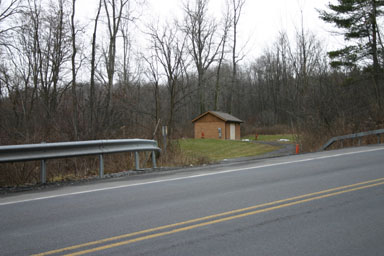
Varna water pumping station from the street
Update: Duane Testut, Treasurer of the Varna Volunteer Fire Company, wrote to explain why there are two hydrants around the pumping station near the F.H. Fox bridge.
If the pump should fail or require maintenance, VVFC (the fire company) brings down one of their big pumps - either the tanker or the engine capable of 1250 and 1500 gpm respectively - and hooks up to the lower hydrant as an intake to the pump and the upper hydrant as a discharge. The water to the tanks at NYSEG is now flowing again.
I never thought of fire trucks being used that way, but if something goes wrong with that pump, it's great to know a temporary fix is that easy.
Next on the right are Cornell experimental fields. They used to be a great place to walk dogs, but sadly that ended a year and a half ago.
School board news in The Shopper
This week's issue of The Shopper includes the latest edition of the Dryden Central School Board Briefs, from the meeting where, as item 4 notes:
35 community members addressed the Board about budget related concerns including: concern about too high a percentage tax levy increase; proposed music cuts; proposed modified sports cuts; proposed new math courses; proposed art cuts; need for retaining the science position funded with a Legislative grant; proposed cut of computer lab teacher assistant at MS; proposed .5 Librarian cut; concern about cutting all programs; proposed reduction in co-curricular offerings; proposed wrestling program cut; fee for the consultant for the superintendent search; proposed technology cut; preserving academics; proposed business cuts; preserving athletics; adding to the tax levy; consolidating elementary schools
If anyone wants to join the conversation on the board side, another ad in The Shopper notes that there are three three-year terms up for election on May 18th. Petitions with 31 signatures are due by 5pm on April 19th in the District Clerk's office.
(I've put up an archive of recent Board Briefs, though it's not quite complete.)
April 10, 2004
Easter egg hunt, giving a political laurel
This morning's Ithaca Journal is quiet, with only two Dryden-related items.
There will be an Easter Egg Hunt at 1pm today in Montgomery Park (directions), presented by the Town of Dryden Recreation Department in partnership with Specialty Trophies and Neptune Hose Company.
On the editorial page, Murray Cohen of Dryden gives a laurel to "our area residents who had the prescience to actively oppose the Iraq war well before it began and wound up becoming the disaster it is today."
Early settlement
Back in December, I posted George Goodrich's telling of the first resident of Dryden with a valid claim to his land, George Robertson. The following chapter looks at the people who arrived shortly after Robertson and the work they did establishing settlements in the early town.
The first grist mill in Dryden, early development of Ellis Hollow Road, a strange story involving shortcake and cream, and Goodrich's cynicism about his own times relative to those of the early pioneers are a few of the highlights.
Chapter VI.
Other Settlements of 1798 and 1799.
In the fall of 1798, three families settled at Willow Glen. They consisted of Ezekiel Sanford, his wife and one son, David Foote, his wife and four daughters, and Ebenezer Clauson, his wife, one son and two daughters, making in all a party of fourteen persons, who came to Dryden over the new State Road, from the Chenango river, which a single team of oxen drawing a heavy ox sled of the olden times, which was made with wooden shoes and a heavy split pole. This conveyance carried all of the household furniture of the three families, which we infer from that fact could not then have been very rich in housekeeping materials. Sanford located opposite the residence of the late Elias W. Cady, Clauson on the premises now owned and occupied by Moses Rowland, while Foote built his log hut between the two. They are said to have passed a very "comfortable winter," subsisting largely upon the abundant game found in the new country, the oxen being supplied with plenty of browse from the trees. That they were able to live through the winter at all in this way is a mystery to us of the present age, who are supplied with so many of the comforts and luxuries of life. It seemed to the writer at first impossible that cattle could be wintered on "browse" without hay or grain, but he is assured by old men that such is not the case, and that it was not uncommon in old times when fodder was scarce to fell trees in the woods, especially maple and basswood, so that cattle could have access to the tops for their subsistence. We are also reminded that wild deer wintered in the woods in this locality, when the snow was deep, without this assistance of the woodman. These new settlers did survive and seem to have prospered in their homes, and as proof of these facts we know that our present popular highway commissioner, Sanford E. Smiley, is one of a large number of descendants of that same pioneer, Ezekiel Sanford, one of the party who wintered their oxen on browse and themselves on the "abundant game found in the new country" in the winter of the year 1798-9. Like Amos Sweet, who had preceded them one year, they seem to have had, when they came, no permanent title to the land upon which they located, but came empty handed to grow up with the new country as they did, having become the ancestors of many of its now prosperous inhabitants.
The writer was at first unable to learn whether any of these three pioneers except Sanford left descendants now residing in the township, and was surprised to learn that both Mrs. Darius Givens and Mrs. Robert Sager are grandchildren of that same David Foote. Clauson, with all his family, is believed to have moved further west, one of his daughters having married a brother of Wyatt Allen, formerly of Dryden.
Others who settled in 1798, coming here from Lansing, where they had sojourned a short time, were Daniel White and his brother-in-law, Samuel Knapp, a soldier of the revolution, who was engaged in the battles of Trenton, Princeton, Stony Point, Brandywine and Monmouth. Knapp took up his location on Lot No. 14, where he raised a large family and died July 1, 1847, aged 91 years. His remains are buried in the Peruville cemetery. Mr. White gave his attention to the construction of the first grist-mill of the town, which stood about forty rods west of the present grist-mill in Freeville, just north-west of where the highway now crosses Fall Creek. He procured a stone which he found out on the Thompson (now Skillings) farm, split it and himself dressed out and took to the mill the first millstones, which answered the purpose and were in constant use until the mill was reconstructed in 1818. His mill was completed in 1802, prior to which time the pioneer was obliged to take his grist to Ludlow's Mill (now Ludlowville) to be ground, or pound it into meal in the hollow of a large stump, as was sometimes done by hand. During the past summer parts of this boulder out of which Mr. White worked these first millstones, were brought to the grounds of the Dryden Agricultural Society by Samuel Skillings, a descendant of Samuel Knapp, and left near the new log cabin, where they will remain as a relic and reminder of the use which Mr. White made in 1802 of a part of the rock. Besides being a practical miller, Mr. White was an ordained deacon of the M. E. church and preached on the Cayuga circuit in 1802, and for several years afterwards. He came to Lansing from Pennsylvania but was originally from Roxbury, Mass., and died at the age of seventy-eight, leaving a family of fourteen children, of whom the only present survivors are Daniel M. White, of Dryden, secretary of the present Centennial Committee, Mrs. Anna Monfort, of Peruville, and Mrs. George F. A. Baker, of West Dryden. Many of his grandchildren and great-grandchildren are now living.
Aaron Lacy, father of the late John R. Lacy, came from New Jersey and settled at Willow Glen early in the year 1799, on the corner since occupied by the Stickles family.
Zephaniah Brown came from Saratoga and settled on Lot 71, adjoining the town to Ithaca, in the year 1799, cutting the first road from that portion of the town to Ithaca, which was extended two years later by Peleg Ellis to the Ellis Hollow neighborhood. Brown seems to have been the first pioneer in that part of the town and resided for a number of years on the farm since occupied by Chauncey L. Scott. But in about 1830 he and his family moved to Michigan, leaving, so far as we can learn, no descendants in the town.
Tradition has handed down to us an incident of being here preserved of the first visit between the two pioneer families of Peleg Ellis and Zephaniah Brown, after a path had been made connecting their respective clearings in the forest. Mrs. Ellis came to make her call upon her new neighbor on horseback, one of her little girls sitting in front of her and the other behind. As they emerged from the woods into the clearing Mrs. Brown saw them and anxiously called out to her husband in a voice loud enough to be heard by Mrs. Ellis : "Zephaniah! Zephaniah! Mrs. Ellis is coming. What shall we have for tea?" To which her husband replied in a voice still heard by the visitor: "Make a shortcake! Make a shortcake and put the cream in thick ; put it in thick, I say."
Society did not then require of Dryden neighbors the formalities, and shall we say hypocrisy, now in vogue ; but who can say that there did not then exist among these pioneers dressed in homespun clothing and living in their log houses in the clearing, more genuine, heartfelt hospitality than exists to-day, among their more polished descendants in their expensive mansions, furnished with all that modern luxury and elegance can suggest?
Goodrich, George B. The Centennial History of the Town of Dryden, 1797-1897. Dryden: Dryden Herald Steam Printing House, 1898. Reprinted 1993 by the Dryden Historical Society. Pages 17-19.
(The Dryden Historical Society, which sells this book, may be reached at 607-844-9209.)
April 11, 2004
Places of Worship
Easter Sunday seems like a good day to add a list of churches and other places of worship to this site. For now, the list includes only places of worship that are in the Town of Dryden, except for McLean Community Church and Peruville New Testament Church, which are just outside the town.
I'll be adding more places of worship over time, especially to cover denominations and religions which meet outside of the Town. I'll also be adding more information about these places, and you're welcome to contact me with additional information, places I've missed, or mistakes I've made.
- Assembly of God
-
Dryden Assembly of God
87 West Main
Dryden, NY 13053
607 844 9985
(map)
- Baptist
-
Dryden Baptist Church
138 Virgil Hill Road
Dryden, NY 13053
607 844 8319
(map)
- Bible
-
Bethel Grove Bible Church
1763 Slaterville Road
Ithaca, NY 14850
607 277 3333
http://www.bg.org/
(map)
- Church of Christ
-
Finger Lakes Church of Christ
9 Highland Drive
Dryden, NY 13053
844 8066
(map)
- Community
-
Etna Community Church
2 Lower Creek Road
Etna, NY 14850
607 347 4898
(map)
- Non-denominational Christian
-
Covenant Love Community
1768 Dryden Road
Freeville, NY 14850
607 347 4411
http://covenantlove.net/
(map)
-
Peruville New Testament Church
Peru-South Lansing Road
Groton, NY 13073
607 898 5287
http://www.angelfire.com/ny4/Roknar/
(map)
-
Reach Out for Christ
318 Johnson Road
Freeville, NY 14850
607 844 3000
http://www.rofc.org/
(map)
-
Temple of Truth
2 Cook Street
Freeville, NY 10368
607 844 4658
(map)
- Presbyterian
-
Dryden Presbyterian Church
6 North Street
Dryden, NY 13053
844-8321
(map)
- Roman Catholic
-
Holy Cross Church
375 South George Road
Freeville, NY 13068
607 844 8314
(map)
- Spiritual Center
-
Foundation of Light
391 Turkey Hill Road
Ithaca, NY 14850
607 273 9550
http://www.foundation-of-light.org/
(map)
- United Church of Christ
-
McLean Community Church
44 Church Street
McLean, NY 13102
607 838 8234
(map)
- United Methodist
-
Dryden United Methodist Church
2 North Street
Dryden, NY 13053
607 844 9861
(map)
-
Ellis Hollow Community Church
1768 Ellis Hollow Road
Ithaca, NY 14850
607 844 8760
(map)
-
Freeville United Methodist Church
37 Main Street
Freeville, NY 13068
607 844 8760
(map)
-
Varna United Methodist Church
965 Dryden Road
Ithaca, NY 14850
607 277 7910
(map)
Infrastructure issues
A lot of Thursday night's Town Board meeting was spent on infrastructure issues, ranging from sewer issues to cell phone towers to roads.
The meeting included two public hearings on sewer districts, one affecting the area north of the Village of Dryden and one affecting the Varna area. The Board changed the billing for the Cortland Road Sewer District so that it operates on billage by usage, at 125% of the rate for customers in the Village of Dryden, making it more like the billing used in the Village. This should lower the rates for most users; TC3 and its dormitories were cited as the two large users who will have to pay more than they did under the unit-based system. Billing will also now be quarterly. The contract with the Village for that sewer district has expired, and the Town Board approved sending the Village a letter of intent about moving forward on sewer contract negotations (but not water, a contested issue).
In a move affecting the Varna area, the Town Board approved modifications to the Joint Sewage Treatment Plant Phosphorous Removal Improvement Project, agreeing to pay Dryden's 1.9% share of a larger estimate for improving the City of Ithaca's wastewater treatment plant. Responding to questions about why Dryden was paying for the City's work, Town Attorney Mahlon Perkins noted that it was a partnership, and Supervisor Steve Trumbull quipped that "We get hooked into everything in the Town of Dryden." These extra costs will only affect the sewer districts connected to the City system, not the town generally.
There were supposed to be two public hearings about cell phone towers, but only one applicant showed up. Nextel, represented by attorney Jaqueline Murray, had applied to replace three whip antennas on the Walker Road tower with twelve panel antennas. The only change would be to the antennas - no additional towers or changes to towers would be necessary. The town's telecom consultant couldn't make it, but Henry Slater, Code Enforcement Officer, said that he had found this largely standard.
Ray Bakos, who lives across the street from the tower, had concerns with traffic and radiation generated by the tower. He complained of being unable to get out of his driveway as cell phone trucks raced past, as well as that the tower had blocked out his TV and radio and forced him to get a different cell phone. Murray noted that the tower produces "a fraction of what the permissible radio frequency exposure limit is under federal law", though that didn't seem like a particularly direct answer. Towers can be as close to the house as one and a half times the fall radius.
After discussion of terms, the town modified some of the consultant's recommendations in approving the contract, mostly lessening their requirements. Later in the meeting, the town voted to sign a contract with a new telecommunications consultant, William Sitzman of Trumansburg, pending confirmation that he had adequate ($1 million) professional liability insurance, and discussed streamlining the existing laws regarding telecommunications approvals.
In the Highway Report, Highway Supervisor Jack Bush talked about coordination with Rick Dietrich of the Youth Conservation Corps, which was hoping to work on some start-to-finish projects. Suggestions (some of which came from the Recreation Department) included a canoe rack at Dryden Lake, an outhouse at Montgomery Park in the Village of Dryden, and work on a baseball field.
Bush had assembled some material for Councilmen, which was distributed at the meeting, prompting Marty Christofferson to complain that "I got a big packet tonight. How come I got that packet tonight and not a week ahead of time?". Bush noted that he'd had the packet in to the Supervisor's office a week prior, but apparently it hadn't gone out to board members. Christofferson noted that "It's just very frustrating getting stuff at this table, having a stack of bills to review, all the other action items we have... I don't know where it all falls, but this is important." Town Clerk Bambi Hollenbeck replied that "We're trying."
Bush had a few items for the Board. He'd been talking with Tompkins County Soil and Water about a tire cleanup day, where people could bring in old tires for a discounted fee and the town would get a portion of the money without having to do much more than haul the tires. He also requested $80 for highway school, which was approved.
In larger projects, Bush noted that the mapping for the Hunt Hill and Genung Roads was complete, and that he'd be setting up meetings with community members, who have been attending Town Board meetings regularly, through a mailing. Also, the Freese Road sewer pump work was in progress, and Bush noted that the county was doing work on the adjacent bridge and found more to repair than expected, so it will take about an extra week. The water pipes on that bridge had leaked in 1996 after an accident, and the town will be doing intermittent work on the old insulation for those pipes later this year.
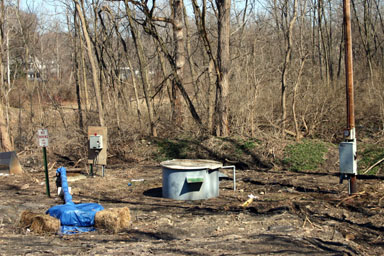
Sewer pump work at Freese Road
The town is also talking with the Bolton Point Water System about flow tests and paint for fire hydrants, but hasn't heard back yet.
In issues related to infrastructure management, the Town Board voted 5-0 to cover elected full-time employees of the town (the Highway Superintendent and Town Clerk) under the same insurance terms as appointed full-time employees, retroactive to January 1st, following up on discussion from the previous meeting.
Finally, just before executive session, the board voted on an appointment that may affect Dryden's infrastructure over the long term, appointing Jim Crawford, publisher of the Herald-Examiner, to the Planning Board. Councilman Mike Hattery said that Crawford's appointment would add "balance in terms of perspective in planning" in addition to the geographic balance of having someone from near Etna.
(Full disclosure: I applied for the Planning Board in December as well, but didn't even get an interview. It will probably be easier to cover from the audience than the table, though!)
April 12, 2004
Bullying, speeding
The Ithaca Journal reports that there will be a talk about character education and bullying tomorrow night at 7pm at Dryden Middle School/High School. The speaker will be Cornell Researcher Dr. James Garbarino, co-author of And Words Can Hurt Forever: How to Protect Adolescents from Bullying, Harassment, and Emotional Violence and Lost Boys : Why Our Sons Turn Violent and How We Can Save Them.
They aren't specific to Dryden, but the Journal also has a trio of articles on a subject that happens here every day: speeding. They have a general piece on increased speed, especially high speed, in the U.S., a piece on the enforced speed limits relative to posted ones, and a piece on local enforcement.
TC3 beginnings
Mary Hornbuckle of the Dryden Town Historical Society sent this announcement for an event to be held at the Dryden Village Hall (map) a week from tonight:
Tompkins Cortland Community College (TC3) sits on a hill overlooking the town of Dryden. Founded in 1968, it offers a wide range of educational opportunities to students of all ages. On Monday, April 19, 2004, the Dryden Town Historical Society will examine the early years of this respected community institution. Ron Space will lead the discussion and anyone with memories or comments is invited to share their experiences. We especially welcome TC3 board members, faculty, students, administrators and employees.
The program will be held in the Dryden Village Hall (corner of South and George Streets) beginning at 7:30 PM. This event is free and open to all and elevator access is available.
Fire company issues
The Town Board meeting was held at Neptune Fire Hall because of an awards presentation, on the Length of Service Awards Program (LOSAP). Robert Barber of McNeil & Company came from Cortland to explain the program, a defined contribution program where the town would make a contribution to a fund and volunteer firefighters would eventually receive a pension-like benefit, kind of like a 401(k) program.
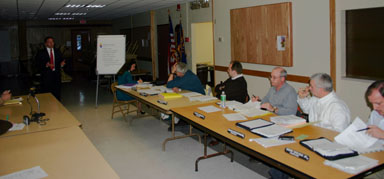
Bob Barber explains the LOSAP program to the Town Board
The town's contribution and the payout would depend on a point system, likely based on a point system sample McNeil passed out at the meeting. The board can tweak the point system, though McNeil suggested that modifying the sample too dramatically might increase the board's exposure to complaints or liability. Councilmen Michaels and Stelick sounded like they'd like to have the companies come together on the points system.
Doug Cotterill of Cotterill Insurance had started on an informal census of eligible firefighters, finding about 60 at Neptune Hose, 30 at Varna, and 25 at Freeville. (He hadn't yet done one for Etna.) Based on that and a $240 contribution, he estimated the likely annual cost based on a system like the sample at around $25,000 for Neptune, and around $45,000-$50,000 total.
Barber asked the town to come up with "a level of funding that you anticipate that you could make," to simply the process of designing a program. Once the program is designed, 60% of the board would have to vote for it (a simple majority on a five-person board), and there would have to be a referendum before the plan was adopted. If it was adopted, there'd be an enrollment period with a formal census. The town would sponsor and contribute to the fund, and the fire companies would have to provide information on points earned by their members. Lists approved by the chiefs would be posted for thirty days before being submitted to the town. It would have to cover all departments in the district if approved.
The board didn't take formal action on the proposal - there's more work to be done sorting out the details - but sounded broadly supportive of the proposal.
Later in the meeting (and off the agenda), Councilman Christofferson brought up an addendum to this year's fire contracts. The addendum would modify the terms of the Neptune, W.B. Strong, Varna, Etna, and Brooktondale contracts. (Varna has already signed and returned the contract.)
Christofferson's addendum would modify the audit clause, stating that the town has to pay for all costs of any audit, without the limit in the original contract. Christofferson said the language in the current contracts wasn't the same as last year, though this was the first Town Attorney Mahlon Perkins had heard of it. The other clause modifies the requirement that capital funds be treated as separate funds by permitting fire companies to borrow against them "for emergency and unforeseen major expenses" with the approval of their board, with no terms set for repayment.
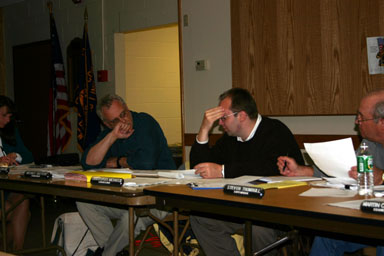
Hattery, Michaels, and Trumbull confer during discussion of fire contracts.
The board, apart from Christofferson, didn't seem to be in a rush to make these changes. Michaels pointed out that rent for a temporary building was the only case "after a lot of discussion" that anyone had come up with that wasn't actually a capital expense.
Christofferson replied that "it's now April, and as a matter of expediency... if these are things that people have all agreed to, and there's a concern about clarity in the contract, instead of taking another month here, a month there, a month there, to get the language cleaned up, we leave the existing contract as is and add this addendum, so we don't have to approve another contract and go back and forth with the companies."
Michaels had heard of some issues Neptune had, especially around the capital reserve issue. Attorney Perkins was concerned about Christofferson's proposed revision to clause 17, feeling that the costs of the auditor were already covered, and that the limit of $1000 provided a cap, and "I'd just want to make sure that this doesn't mean we'll pay any amount they present us with."
Perkins asked about the lack of terms for the boards to repay borrowing against capital reserves. Christofferson suggested that "borrowing means paying it back. It's not taking it out and not paying it back. Does it need to be paid in the same year, or a couple years, whatever - I think fire boards will hopefully do due diligence to pay that back."
Michaels was also concerned that borrowing should only happen for large expenses, noting that "borrowing $1000 against these funds is ridiculous."
Christofferson replied that "my concern is that it gets worked out, like tomorrow."
Michaels asked for clarification that it get paid back, and the board authorized Supervisor Trumbull and Attorney Perkins to negotiate further with the fire companies.
April 13, 2004
Dryden schools levy to increase 15%, avoiding drastic cuts
This morning's Ithaca Journal reports that the Dryden Central School Board voted 7-1 for a budget that includes a 15% tax levy increase but avoids program cuts residents had opposed. Three teaching positions - two funded by a grant and one a retirement - are still eliminated. The tax rate will climb about 8%, to $23.57/$1000 assessed value. The board is counting on slightly more aid than Governor Pataki proposed, and increasing building usage fees from $5 to $10 an hour.
There's also a profile of Susan Lang, a Cornell science writer who lives on Ellis Hollow Creek Road, whose latest book is 'Beating the Blues', about dysthymia, a mild form of depression.
Finally, there's a note about the Freese Road bridge. As Town Highway Superintendent Jack Bush noted on Thursday, it will stay closed an extra week, to April 22nd.
Organizational issues and grant-writing
The Town Board spent some time in its April meeting discussing the organization of town government, as well as on hiring a grant-writing firm to focus on new projects.
The board followed up on the presentation made at the February board meeting by Bernie Thoma of Thoma Development Consultants, examining a contract for grant-writing services.
Councilman Marty Christofferson asked a few questions about this contract, in which Thoma offers grant-writing services for $100 a month, payable quarterly, plus a percentage of grants received, minus a refund on the monthly fee if the percentage yields more than $5000. Christofferson saw inconsistencies between clauses about billing, and Town Attorney Mahlon Perkins said they would examine it before signing it.
Christofferson also brought up the needs analysis Thoma would perform at the start of the contract, an "opportunity to give our ideas to the folks who will be talking to them." Hattery noted that the Village of Dryden had done this, and included the whole board. County Legislator Martha Robertson asked if the public would have a chance to participate in this needs analysis. She received a cold response from Councilman Hattery, who asked "Are we going to entertain questions from the floor?", and got a 'no' from his fellow board members.
The board approved the contract contingent on resolution of the issue Christofferson had brought up. Hattery also noted that he didn't think this contract would preclude other grant development work the county is starting.
The board also looked at a draft organizational chart for the town, along with a directory (30K Excel or 73K PDF; both have been stripped of email addresses).
Councilman Michaels emphasized that he felt "the Town Board should be up there reporting to the taxpayers." (While I can sympathize with the sentiment, there's one major flaw in putting that into an organizational chart: the board is legally reponsible to voters, not taxpayers. Some voters don't pay taxes, and might even, if they were living somewhere for free, not feel their effect. Other taxpayers don't have a vote, either because they're not U.S. citizens or because they own property in the town but can't vote - for instance because they don't live here or because the taxpayer is a corporation. I'm not entirely sure what the lines crossing between the Town Attorney and Town Supervisor mean, either. It is, of course, a draft.)
There were also some questions about revising the organization itself, especially around who the environmental planner should report to, but those were held for later discussion.
The directory seems like an extremely useful and uncontroversial thing to have, though for privacy reasons the version here (30K Excel or 73K PDF) has the email information removed. It's a quick way to see who is on what board, for how long a term, and what the vacancies are.
Both the chart and the directory were produced by Lisa Stelick, as part of her work on the Dryden Recreation Commission.
Near the end of the meeting, two personnel issues, both boxes in the organization chart, were raised. Town Supervisor Trumbull noted that he had received a letter from the Town Historian, Elsie Gutchess, announcing both her resignation and her plans to privately publish a bicentennial history of the town and a book on schools of the town. Councilman Michaels suggested that any work she had done so far on such projects was clearly work for hire, owned by the town by virtue of her employment by the town for a $200 annual stipend, though he acknowledged that they didn't have evidence that she'd written yet, so that might not be enforceable. Of greater concern were questions about materials people had given her but not received back; Michaels suggested that they were given her in her role as Town Historian, not privately, and should be returned. Asked about how to do this, Attorney Perkins suggested "Ask her."
Finally, the town has found a new bookkeeper, Dawn Bogdan, who has been working for the Town of Lansing. The bookkeeper position is a supervisor's appointment and doesn't require consent of the board, but they seemed pleased to have her.
Entering Varna
Moving past the driveway for Cornell's experimental fields, the next building is apartments.
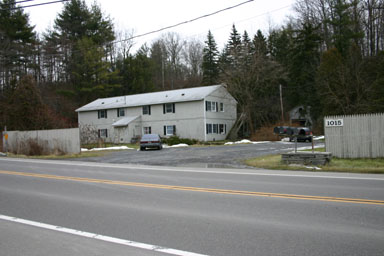
1015 Dryden Road (map)
At 1013 Dryden Road, there are a front and a back building.
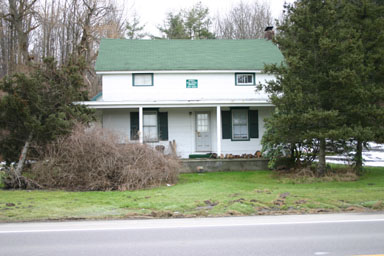
1013 Dryden Road, front building (map)
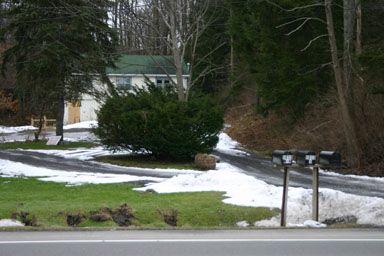
1013 Dryden Road, rear building
Across the street is the sign for the hamlet of Varna.
New Dryden Democratic Committee Chair
The Town of Dryden Democratic Committee met tonight for the first time since January and elected a new Chair: Simon St.Laurent, me, the author of this weblog. I've updated the disclosures page to reflect this, but figured it was worth noting in a story. I don't expect it will change anything here.
If you're interested in participating in local Democratic party efforts, please contact me or email me.
April 14, 2004
Former bookkeeper indicted, Freeville police reduction, more
Liva Brong, former bookkeeper for the Town of Dryden, has been indicted on multiple forgery-related counts connected to accusations of writing $17,900 in checks to her boyfriend's business, reports this morning's Ithaca Journal.
Because it's a Wednesday and their new Our Towns section on Dryden and Groton is included, there's lots of Dryden news today, including:
- An article on Freeville's reduction of contracted Village of Dryden police hours from 55 to the original 50,
- Cathy Wakeman's Dryden Town Talk column, focusing this week on Sis Johnson's knitting of items for donation to a wide variety of area organizations,
- An Ask Your Public Official with Sheriff Peter Meskill about speeding enforcement,
- Briefly in Dryden, noting a Dryden Middle School performance of "Fiddler on the Roof Jr.", April 22-24 at the Dryden High School auditorium at 7pm, as well as a boat safety course at TC3,
- and a Neighbors section noting that Air Force Captain Christopher Wood has received a master's degree in acquisition management from the Air Force Institute of Technology.
The printed edition includes information on housing values.
On the opinion page, there is a letter from Bill Cornell of Dryden about deer damage and the prospect of giving hunters a longer season rather than sanctioning year-round hunting by farmers.
In county news, the legislature's Budget and Capital Committee passed a goals statement that suggests limiting tax levy increases to 3% in 2005 and 2006.
Planning Board meeting tomorrow on agriculture, transportation, Etna
The Planning Board will be meeting tomorrow night at 7:30pm at Dryden Town Hall (map). Their focus will be on the Draft Comprehensive Plan, particularly agriculture and transportation.
Last month's Planning Board meeting was pretty active, and closed with concerns about agriculture.
Update: David Weinstein reports on an addition to the agenda:
A sketch conference will be held at Thursday's Planning Board meeting for a new proposed subdivision on a 100 acre parcel on the southwest corner of the intersection of Wood Road and Sheldon Road, north of Etna Rd. It is being called the Daniel Armitage Subdivision. It calls for 7 house lots that apparently range in size from 1.5 to 7.5 acres each, but may also include some additional large back lots. This was added to the agenda late.
This will be the third proposed subdivision this year for this area west of Etna, including a proposed 36 unit development on Wood Rd, and a 4 unit subdivision on Etna Rd between Wood Rd and Caldwell Rd.
Recreation issues at April Board meeting
The Recreation report at the April Town Board meeting combined the usual reporting and conversation with a slideshow of initial analysis of the survey (241KB PDF, unfortunately slightly crumpled).
Recreation Coordinator Jennifer Glaab began with the recreation report, noting that contra dancing turnout had varied from zero in Varna to 45 in Dryden and 25 in Freeville, with one remaining dance in Bethel Grove, which was going to have the extra benefit of George Wilson fiddling.
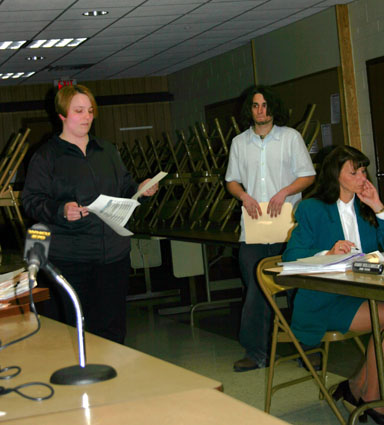
Recreation Coordinator Jennifer Glaab gives the recreation report with Carlo Marino waiting to give his presentation and Town Clerk Bambi Hollenbeck recording minutes.
The Shanty Band concert on April 3, had only had 10 attendees, probably because it was the first day of spring break. The egg hunt was still to come. Glaab noted that in addition to the Pepsi Pitch Hit & Run on April 24th, the would also be a Sierra Mist Dribble Pass & Score soccer competition on May 22nd. 39 kids had registered for lacrosse and applications were still coming in. Kiwanis Baseball and Softball had 304 registrants, and will kick off with a coaches' meeting on April 15th. Archery was starting April 13th, and still had a few spaces open.
Ithaca College student and recreation intern Carlo Marino presented the first fruits of his analysis of the surveys. He provided information on overall popularity of class options, as well as breakdowns by age, interest in paying for equipment, maximum price, and preferred location. (That information is also available in a Excel 104KB file.)
Marino acknowledged that this only reflected part of the survey results, and was still working on analyzing the rest of the data. There were also questions about how the survey was conducted. Glaab replied that the survey had gone out in The Shopper in January and was still coming in, slowly. Councilman Stelick noted that they had also been at the Town Hall and community centers. (My crumpled copy comes from the Draft Comprehensive Plan informational meeting I attended in December.)
County Legislator Martha Robertson asked whether the responses pointing to the Village of Dryden as a preferred location reflected a disproportionate number of replies from the Village. Recreation Commission member Lisa Stelick said that it was "distributed widely... in community centers, fire halls." Glaab said that they could work on an analysis of the address information respondents (optionally) provided as well.
Dryden Courier examines school budget, firefighter benefits
This week's Dryden Courier takes a close look at the Dryden school budget, particularly the business education position that was saved by the current proposal. There's also coverage of the proposed LOSAP benefit package for volunteer firefighters (which notably explains that the "buy-back" plan discussed at the board meeting would extend benefits five years back retroactively) and a look at the sports complex currently being built in Cortland.
April 15, 2004
News including Dryden
After yesterday's relative torrent of Dryden news, today's Ithaca Journal is fairly quiet about Dryden. Three pieces definitely affect Dryden, though:
- The state Department of Environmental Conservation's Wildlife Management Unit 76, which includes Dryden south of Routes 13 and 366, is aiming for a 36% decrease in the deer population through increased hunting.
- Congressman Sherwood Behlert is getting an early start on fund-raising. Potential Republican primary challenger David Walrath is getting some assistance from the Club for Growth, while Boehlert has had help from the Republican Main Street Partnership.
- The Journal's editorial supports the effort to keep the county tax levy within a 3% increase for the next two years.
There's also a piece in the New York Times (registration required) that Verizon is considering selling off its upstate lines, which include part of Dryden. The first two paragraphs:
Verizon, the state's largest local telephone company, said Wednesday that it was considering selling off all its phone lines in upstate New York, prompting some state lawmakers and union officials to warn that jobs and service quality could be put at risk.
Paul A. Crotty, the group president for New York and Connecticut at Verizon, told a State Assembly hearing here that the company had "asked for expressions of interest" from companies that might consider buying its 2.5 million phone lines in upstate New York from Orange County out to Buffalo. But he said that no sale was pending.
What you need to do this
I've had a few questions recently about how I write this and what it would take to do something similar - how much technical knowledge is required, what it would cost, what equipment, what software, etc.
The software I use to manage this site is called Movable Type. To write an entry, I open up a web site that presents me with a form. I type my entries directly into those forms, and pick categories. I can also customize the way that the information is presented and the way the site looks generally, which I do every once in a while. (Wordpress offers similar features.)
For the most part, I use very simple HTML in the entries - probably seven or eight pieces total - so I just type it in directly. You can get by without knowing any HTML to start with, as Movable Type can manage basic formatting for you, and learn the bits of HTML you need along the way. Alternatively, you can use an HTML editor and copy and paste the HTML into the forms.
I already had a web site, so setting this up was a matter of asking my provider to get it going. (More recently, I manage it myself, on a server in Ithaca.) If you don't have a web site, there are other ways to do it. You can set up a site through TypePad, a service provided by the same people who create Movable Type. Similar tools and hosting options are available through Blogger and Radio Userland.
A digital camera is really helpful, if you want to include photographs. You don't need a fantastic camera to create pictures to display on the Web, but you'll probably want to use it for other things as well. Pictures of people at meetings are surprisingly difficult to get, largely because of flash and distance issues, but most pictures are easier. (Sports photos are always hard.)
You'll also want software for editing those pictures. I use Photoshop Elements, which came with my camera, but PaintShop Pro and the full version of Photoshop are also good alternatives, as is the GIMP, a free program. Much of the editing I do is to correct flash pictures that didn't get enough light because I was too far from the subject.
On the reporting side, if you wanted to do that, note-taking is really important, though I'm also using a voice recorder. Listening to two or three hours of meetings isn't much fun, especially since the recorder always seems to pick up more noise than I hear when I'm there. Notes help me minimize that repeat listening. The notes are the foundation, and the recording the backup.
There are a few things more important than the technical stuff, though. The first is interest - there are lots of weblogs that ran a week or two and ended because their creator didn't find it exciting enough to pursue. Time is similarly critical. There's no obligation to update a site every day, but it does keep readers coming, and helps to build a rhythm. The last thing I'd recommend is a theme or personality of some kind. This site has a tighter focus than most weblogs, certainly, but readers like to come back based on what they found before.
It's also worth noting that most weblogging systems support multiple authors, so if a group of people wants to share a site, that's possible too, and it's one way to avoid the time and interest drain.
Just inside Varna
After the sign for Varna, there are a modern house on the left followed by apartments with offices and laundromat set well back from the road.
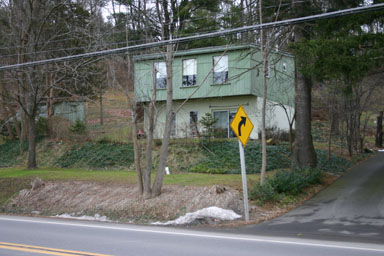
999 Dryden Road (map)
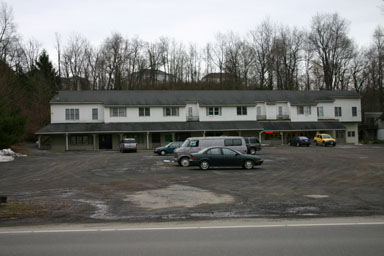
993 Dryden Road (map)
April 16, 2004
The Meeting Master
I've had stranger titles, but the Ithaca Journal's Jennie Daley gives me that one in Meeting up with the meeting master, in which she profiles the work I've done on this blog.
Most of it echoes our conversation at Googer's verbatim - I wish I could take notes like that! - but there are a couple of minor things. I haven't yet been to a Conservation Advisory Board meeting, though I'm planning on getting there soon. I've been writing for six months but only attending meetings for four months, though I think I'll reach six months soon enough! Also, at the time of the interview, I was a member of the Dryden Democratic Committee, and Tuesday I became the Chair.
I can't say I thought much of this would happen when I started this, but as adventures go, this one's going very well.
Update: Jon Udell of Infoworld Magazine picked up this story and talks a bit about how it connects to the potential of weblogging more generally.
Lane challenges annual assessments
This morning's Ithaca Journal reports that County Legislator Michael Lane is proposing legislation to shift from annual assessment to a three-year cycle., though it isn't clear how much support there is for that in the legislature. A simultaneous combination of rising assessments and rising tax levies has made a lot of people angry, and Lane says that "I think we need to take a break."
(I've noted before that I like accurate assessments and think the main problem is on the tax levy side, but I can certainly see where he's coming from.)
Today's Journal also includes a listing of recipients of Community Arts Partnership Grants, including the Town of Dryden and the Constance Saltonstall Foundation, as well as a criminal contempt charge with an unusual setting and a letter about mutual respect from Alicia Alexander of Dryden.
Businesses at Mount Pleasant Road
Just west of the apartments and shops with the vast parking lot are two businesses. The first is apparently a tile business, and the second is Autoworks.
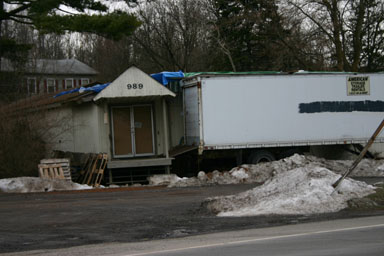
989 Dryden Road (map)

987 Dryden Road, Autoworks (map)
April 17, 2004
Letters on Republicans and Christians, speeding
This morning's Ithaca Journal is quiet on Dryden news but has two letters from Freeville residents:
- Stephen Prentice thanks the Journal for their recent coverage of speeding and notes the dangers of speeding and tailgating.
- Shelley Forsythe writes to say she thinks that "if the religious right were to truly align themselves with a party according to Jesus' teachings, it would be almost any party other than the Republican Party."
County and environmental issues
The April 8 Town Board meeting also included a number of conversations about activity at the county level, making town tax policy match county policy, and about environmental planning in conjunction with the county and the state.
As noted in legal notices, the town had hearings on property tax exemptions for senior citizens and people whose incomes are limited by disability. County Legislator Mike Lane spoke in favor of the exemptions, noting both that it would put residents on an equal footing with regard to town and county taxes and that "it's the right thing to do for senior citizens." The board passed both exemptions, which operate on a sliding scale based on income up to $32,400.
Lane opened the county briefing by noting that the state budget was late once again, but the county was working hard to keep up with the latest news from Albany on likely costs. Lane reported that there hadn't been surprises so far, but there "could be things we don't anticipate in the fine print."
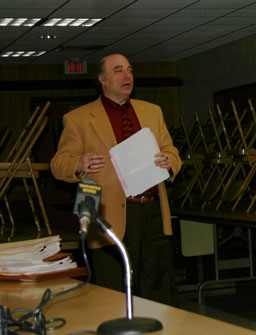
Mike Lane discusses the state and county budgets
Lane noted that the county had decided to participate in the Virgil Creek aquifer study, which would reduce the costs of that project to the town. Lane also discussed the tourism grants made from the room tax, and encouraged Dryden organizations to apply for them, especially the celebration grants of $500 to $1500, which will have another round in the fall.
County Legislator Martha Robertson began by discussing the budget, noting that a preliminary rollover budget, keeping services the same next year as they are this year, would result in a 10-12% tax levy increase - "still real serious, but not quite as bleak as last year." She said that legislator Peter Penniman had heard that costs to the counties would not increase this year, and pointed out an Assembly proposed to put a cap on county shares of Medicaid.
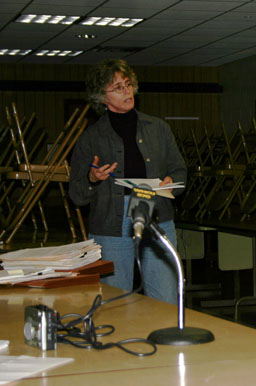
Martha Robertson presents upcoming meetings on the draft County Comprehensive Plan
Robertson also discussed the draft County Comprehensive Plan, in particular that there would be an open house on the subject April 29 at the Dryden Town Hall from 3-7pm, followed by a presentation, and that there would be presentations at the Dryden and Freeville village halls on May 13th and 20th respectively.
Robertson brought up a study that the Learning Web, the Tompkins County Youth Services Department, and the Cornell University Family Life Development Center had done with and on "independent youths", ages 15 to 24 and living on their own, often homeless. (The Ithaca Journal has an article on the study.) Robertson pointed out that 16 independent youths had created and carried out the study, which spoke to 165 people. She presented a copy of the survey results to the Town Board.
Environmental Planner Debbie Gross asked the board to hold a public hearing at their next meeting on the annual stormwater management report, which has to be submitted to the state Department of Environmental Conservation (DEC), and the board scheduled one.
Gross built on Mike Lane's earlier mention of county participation in the aquifer study, pointing out that the county had suggested an additional test well be drilled "to improve confidence in the survey." While there were still questions about the timing of the disbursements, the largest piece of which is likely to arrive in 2005, the overall commitment was fixed. Councilman Steve Stelick thanked former Supervisor Mark Varvayanis and Town Councilmen Deb Grantham and Charlie Hatfield for their
"vision to put the money up on this with no guarantee that the county was ever going to come through with this money. It's nice that the county is backing it, but the former town board had the vision to want to go through with this, regardless if there was funding from the county."
Gross also asked the about an agreement related to the Six Mile Creek watershed monitoring project. The board had authorized negotiations at the previous meeting, but there wasn't yet a contract. The project needs $2350, and Gross provided a rough outline of the contract details. Councilman Hattery asked for more details on the Community Science Institute, and there was a general request that the results be presented to the board. The supervisor is already authorized to move forward, so no further action was taken by the board.
The Town Board also completed a short form State Environmental Quality Review (SEQR) for the annexation of a parcel to the Village of Dryden that they had approved last month.
April 18, 2004
Freese Road, Mt. Pleasant Road, and 366
Just west of Autoworks is an intersection that isn't much fun to drive through. I've mostly been focusing on houses, but felt this intersection (map) important enough - by virtue of being dangerous - that it was worth taking some pictures from inside my car.
From the Mt. Pleasant Road side, the views out of the car are okay. These pictures were taken in light morning fog, and the curve to the west definitely doesn't help, but while it isn't the kind of visibility I'd like to have, especially for a left turn, it isn't terrible.
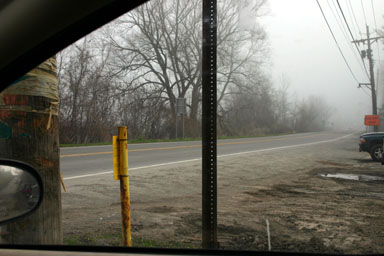
Looking east from Mt.Pleasant Road's intersection with Route 366
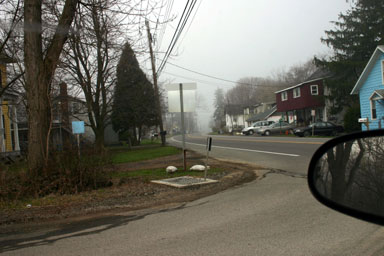
Looking west from Mt.Pleasant Road's intersection with Route 366
Even without fog, however, the views from the Freese Road side aren't very reassuring. The view to the west is particularly well-blocked, even before the road heads into a curve.
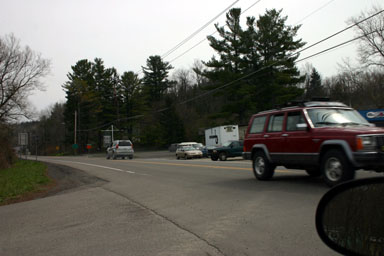
Looking east from Freese Road's intersection with Route 366
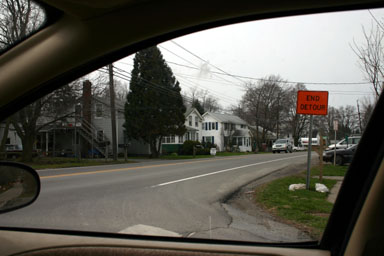
Looking west from Freese Road's intersection with Route 366
Because this might seem like photographic trickery, and because taking pictures from inside cars isn't much fun anyway, here are some extra details. The pictures were all taken from the driver's seat of my 1996 Saturn SL2. The focal length of the lens used to take the pictures was 24 or 25mm for all of the pictures except the one on Mount Pleasant looking east. My camera has a multiplier of 1.6, so they were taken with the equivalent of a 44mm or 53mm lens on a regular 35mm film camera. Distances on most of the pictures therefore look longer than they actually are, and distances in the Mount Pleasant looking east picture look only a tiny bit smaller than normal. The views from Freese Road were taken later in the morning, after the fog had burned off.
I avoid making left turns at this intersection whenever possible, and I'm cautious even about right turns and driving straight through it. Even when I'm approaching it on 366, I keep an eye out for drivers who might not have seen me. I'm surprised that this intersection doesn't have a light, but maybe it hasn't quite reached critical mass for traffic.
(The next intersection up Mount Pleasant Road is pretty scary itself, combining hills and curves in an even more dramatic way, though there's less traffic there.)
Native Americans in Dryden
The signs welcoming visitors to the Town of Dryden say "since 1797", dating it to the arrival of Amos Sweet, but George Goodrich, even while writing a centennial history based on that date, knew that there was activity here before. His chapter on "Indian Occupation" is generous in neither length nor opinion, but it brings Goodrich to the key point necessary for the rest of his story to proceed:
Thus it happened that the early pioneers of our town escaped all annoyance from hostile Indians, who had been effectually driven out of the country before any settlement was attempted.
Chapter II.
Indian Occupation.
Although there is no record that the town of Dryden was ever the site of any permanent Indian settlement, there is abundant evidence that the Indias occupied it as a hunting ground. The little flint arrowheads which are still found, especially along the banks of the streams and upon the shores of the Lake, are unmistakable proof of the presence of the Indians, and the chips of flint, the waste product of the rude manufacture of these arrowheads, and other implements of stone found frequently about the shores of the Lake, indicate that at some time they had there at least a temporary encampment. The nearest Indian villages of which we have any authentic account were the habitation of the Cayugas, near the present site of the city of Ithaca, and extending on both sides of Cayuga Lake to its outlet. Central New York, when first known to civilization, was the home of the "Iroquois," a term applied first to five and afterwards to six confederated Indian tribes, which included the Cayugas and is said to have constituted the most powerful force of Indians on the American Continent. We may perhaps claim some significance in the fact that the part of the territory which now constitutes the central and western part of the Empire State was once the home and hunting ground of the victorious Iroquois, the conquerors of all the neighboring tribes. It was said that such experiences had the New England tribes of Indians suffered from the Mohawks - the eastern branch of the Iroquois - that the very name of "a Mohawk" caused them to flee with terror. The Iroquois had recently conquered the Adirondacks of the north and the Eries and Hurons on the west, and after becoming known to white men, in one of their southern excursions, they rescued from their enemies the whole tribe of Tuscaroras of North Carolina, whom they brought home with them and adopted as the sixth branch of their nation.
The conditions and habits of these aborigines form an interesting study to those who have investigated the subject. The first white men to go among them, except occasional fur traders, were the missionaries of the French Jesuits, who for a century prior to the English occupation of their territory, had lived and labored among them in the vain effort to effect their conversion to their form of Christianity. These, like other American Indians, from the first seemed to take much more naturally to the vices than to the virtues of their white brothers and the sacrifices of those zealous men, who left their pleasant homes in France to live and work among the Indians of North America for their education and development in the Christian faith, were worthy of better success than resulted. But the reports which these French Catholic priests sent back to their native country of their experiences among them are now found carefully preserved in French monasteries, and constitute one of the most interesting and trustworthy sources of our knowledge of the actual condition in which the Indians were then found. The "relations" (as they are called) of one Father Carheil, who spent over twenty years of his life among the Cayugas, and who in the year 1672 describes Lake Tiohero (now Cayuga) and the beautiful county surrounding it, with its abundance of fish and game, have thus recently been resurrected and translated into English, throwing much light upon this subject so interesting to the antiquarian.
In the French and Indian wars, which preceded the Revolution, the Iroquois, in spite of the French priests, took sides with the English, and rendered efficient assistance in the conquest of Canada from the French. When the War of the Revolution followed between the English colonies and their mother country, the Iroquois at first decided to remain neutral, but the most of them were afterward persuaded to join their old allies, the English. This exposed the outposts of the colonies to a merciless enemy in the rear, and the frightful massacres of Cherry Valley and Wyoming were among the results. Fortunate it was for the early settlers of our locality that these bloody times passed before they ventured into the Western Wilderness.
To avenge these outrages and to punish the hostile Indians and drive them from the neighborhood of the advance settlements, an invasion of the Iroquois country was executed in 1779, known as "Sullivan's campaign," which, after a battle with the combined forced of Indians and Tories near Newtown (now Elmira), resulted in their complete defeat, followed by the subsequent overrunning of the Indian country and the destruction of their villages, including those along Cayuga and Seneca lakes. This campaign, forming a part of the Revolutionary war, planned by Washingtons and executed by Generals Sullivan and Clinton with a force of about five thousand men, detachments of which marched within a few miles of the town of Dryden, and perhaps within its borders, resulted in the complete humiliation of the fierce Iroquois, and opened the way for the subsequent purchase and settlement of this section of Western New York, over which up to that time they had absolute sway. With the exception of the Oneidas, who had remained friendly to the colonies, and a part of the Onondagas, whose descendants still remain on their reservation near Syracuse, the Iroquois were driven from this part of the state never to return in large numbers. Some took refuge in Canada and along the Niagara frontier, others, including a number from the Cayuga and Seneca tribes, were colonized in the extreme western part of this state, while most of the Cayugas were induced to make their homes in the Indian Territory, where their descendants now reside in considerable numbers. Thus it happened that the early pioneers of our town escaped all annoyance from hostile Indians, who had been effectually driven out of the country before any settlement was attempted.
Those readers who desire to follow more minutely the details of "Sullivan's Campaign" will find the journals of the officers of that expedition, with full explanatory notes and maps, given in a large volume recently published by the State, a copy of which can be found in the Dryden village school library.
Goodrich, George B. The Centennial History of the Town of Dryden, 1797-1897. Dryden: Dryden Herald Steam Printing House, 1898. Reprinted 1993 by the Dryden Historical Society. Pages 4-6.
(The Dryden Historical Society, which sells this book, may be reached at 607-844-9209.)
April 19, 2004
High-speed chase in Dryden?
I don't typically report from The Monitor, the Ithaca Journal's crime reporting. Lately it seems to have had some stranger entries, though. Today's Monitor reports on a Cortland man who was:
driving east on Fall Creek Road in Freeville when police spotted him speeding at 2 a.m. New York State police followed him at 90 mph before stopping him on Gulf Road behind the McLean Post Office. Officers smelled alcohol...
There's also a letter today from Shirley Woods of Freeville, complaining about a speech Connecticut Senator Chris Dodds gave praising West Virginia Senator Robert Byrd, a former Ku Klux Klan member.
April 20, 2004
Rape charges, bridge staying closed
Today's Ithaca Journal is especially unpleasant reading. The most prominent Dryden story is about a 16-year-old charged with raping a 4-year-old, after investigation of a February 4th incident.
Elsewhere in the Journal, Freese Road bridge will stay closed until the 29th (and Route 13 through Ithaca will be down to one lane through Saturday.)
Ithaca High School continues to have problems with racial issues, this time with graffiti, and the Ithaca City School District is looking at a 5.8% budget increase.
Planning board on subdivision, hamlets, agriculture
Thursday night's Planning Board meeting included a sketch conference for a proposed sudivision on Sheldon and Wood roads near Etna (map) as well as continued discussion of the Draft Comprehensive Plan's sections on hamlets and agriculture.
The Planning Board welcomed new member Jim Crawford, and approved the minutes from the previous meeting, the first minutes to appear on the town's web site in a long time.
The next discussion, which lasted about an hour, concerned the Daniel Armitage subdivision, which Joan Portzline presented. The initial sketch is oriented with north to the right. Sheldon Road's curve is the northern edge of the property in question. Wood Road runs along its eastern edge, and the road on the left edge is Etna Road. Parcels labeled with letters are part of Phase I, and the parcels listed with acreage are part of Phase II, except the lots in the northwest and the one with a a house shown on it, which have already been sold.
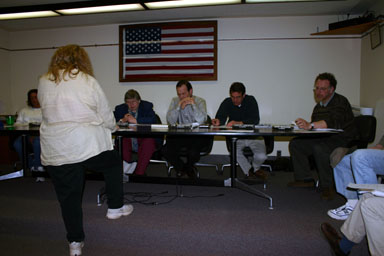
Joan Portzline explains details of the Daniel Armitage subdivision to the Planning Board.
The area used to be Cornell research fields, and all of the parcels in Phase I have access to electricity along Sheldon Road. There was discussion of stormwater management - apparently there had been a presentation on stormwater that afternoon - though the lot already includes drainage put in earlier.
Most of the other questions the Planning Board had related to issues of how responsibilities fall if the property is subdivided and sold to people who develop individual lots as opposed to subdividing and developing it simultaneously, as well as to issues around adding driveways to these lots. Planning Board member Tom Hatfield noted that the line of properties in Phase II would be adding six road cuts in a quarter mile, which would be really dense, and was also concerned about the eight potential driveways into Sheldon Road. There were questions about whether shared driveways were possible; Board member Joseph LaQuatra pointed out a lawsuit in progress against the town over a shared driveway on Bone Plain Road. There were general questions about the use of flag lots - narrow driveways to large parcels.
Deed restrictions also came up a number of times, as Portzline plans to include minimum sizes for houses and restrictions on modular housing, as well as limitations on further subdivision. There is also a county Unique Natural Area near the edge of the property that can't likely be built upon, and there were questions about how much disturbance would be involved in development.
Zoning Department Head Henry Slater announced that another subdivision proposal, for four parcels on Etna Road, had been withdrawn.
The board next reviewed changes made to the Draft Comprehensive Plan at the last meeting. Most of the changes were accepted without new changes, except that the last sentence of the first changed paragraph was modified from "small scale multi-unit" to "small scale single family and multi-unit".
Other changes were meant to ensure that active farms in areas slated for possible future development be encouraged to continue, and there was discussion about changing the maps to show active farms and, as Planner George Frantz said, "consider them reserve areas." Tom Hatfield wanted it made clear that suburban development "would only kick in if these farms are unable to sustain themselves". Frantz noted that the Department of Agriculture and Markets is actively policing zoning and planning to make sure it isn't opposed to the interests of farmers.
Environmental Planner Debbie Gross had a map showing active farms overlaid with the (now outdated version of) the land use map. The map hasn't been revised to show changes in the Etna area and north of the Village of Dryden, and the map of active farmland is approximate, based on tax assessment information from 2003. (If you know of an active farm that's missing, contact Debbie Gross at 844-8655.) It looks like it's missing Cornell fields, which is perhaps not surprising given their tax-exempt status.
Ken Miller, a resident of Richford who farms in both Dryden and Caroline, was concerned that the plan didn't take a different point of view into account: farmers in the agriculturally-zoned areas who want to subdivide their properties. He felt the restrictions on subdivision outlined in the current Draft Comprehensive Plan were "a very poor concept for the farmer," and would lead to lots of brush lots. He was also concerned that there hadn't been any signs of a meeting with farmers, and that he had only just learned of this plan, not having received any notice of it or the survey that preceded it.
Joseph LaQuatra reflected that no one had brought those issues up at all at the public meeting. George Frantz suggested that a Saturday morning meeting with farmers to explain the implications of the plan for farmers would be a good idea. Board members Tom Hatfield and Lisa Stuttle asked for a written explanation of the fixed-ratio zoning described by the plan, with some sample scenarios and descriptions of what would happen if a parcel was no longer used for agriculture.
There were also some questions about how planning for the Etna area had turned out. Skip Thorne of the Etna Community Association was there, concerned about plans for development to the south and west of the hamlet. Planner George Frantz described the proposed changes to the south, removing the industrial area and adding a green buffer between Etna and Route 13, which seemed to go over well.
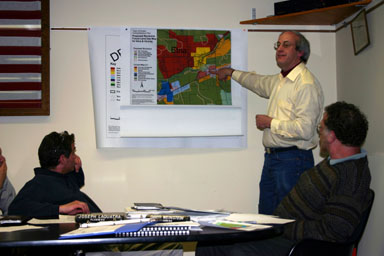
George Frantz shows how plans for Etna have changed.
As the board reached the agriculture section of the plan, Miller also objected to language restricting the kinds of businesses permitted on agricultural land, and a line about "crafty zoning language" that was apparently a typo for "crafting zoning language". The board ran out of time for discussion, and will discuss this in more detail in future meetings.
Joint Town-Village meeting on Cortland Road Sewer District
The Town of Dryden Public Notices page announces that tomorrow night there will be a:
Special joint board meeting with the Village of Dryden Board of Trustees to discuss matters pertaining to the Cortland Road Sewer District, and any other business which may properly come before the board.
That's Wednesday, April 21st, at 7:00pm at the Dryden Village Hall (map).
Freeville hearing on parental responsibility
Today's legal notices include this one from the Village of Freeville:
PLEASE TAKE NOTICE that a public hearing will be held at the Village Hall of the Village of Freeville, 5 Factory Street, Freeville, New York on May 4th, 2004, at 7:30 PM. The hearing concerns a proposed local law, the Parents Responsibility Act, which makes it unlawful for a minor of the age of 15 or less to commit, or a parent of such minor to knowingly consent or permit the minor to be in a public place in the Village of Freeville so as to allow, permit or provide the minor with the opportunity to commit, certain acts defined in the proposed law. The Act provides for procedures to be followed upon violation of its provisions and penalties. A copy of the full text of the Act is available for review at the office of the Village Clerk.
April 21, 2004
A quiet Our Towns
Today's Our Towns section is mostly about Groton, though there are several Dryden pieces in that section and elsewhere in the paper worth attention:
- The Dryden Sertoma Club's 2004 Service to Mankind award goes to William Deming, superintendent of Dryden Central Schools from 1962 to 1980, and Director of the Rural Schools program at Cornell for nine years.
- Dryden Middle School is presenting Fiddler on the Roof from April 22-24.
- The Community Calendar includes events for this week.
- An editorial on speeding uses an Ellis Hollow Road example.
- The Tompkins County legislature voted overwhelmingly to encourage TCAT to change to a public authority, or a non-profit if that isn't possible, to address concerns from the state about its structure.
The Journal lists the Sertoma reception for Bill Deming as on April 17th in the article and April 27th in the Community Calendar. I'll find out which one it is. Update: It's the 27th.
TC3 memories
Ron Space, the first Chairman of the Board of Trustees of Tompkins Cortland Community College (TC3), gave a presentation to the Dryden Town Historical Association Monday night, shedding some light on how exactly the college came to be, and how it came to be in Dryden.
County Legislator Mike Lane introduced Space, and suggested that that "this union of two counties, this intermunicipal system of education, is one of the best examples of intermunicipal cooperation we have." Lane pointed out that the college now serves 3000 full-time equivalent students, has dormitories for 450 students, and is working on a new round of capital projects to move athletic facilities to a fieldhouse to make room in the main building for classrooms.
Space stepped back to 1964, when thoughts of TC3 were just getting started, introducing Walter Franklin of Cortland County, one of the "instigators" behind the community college, and invited Franklin to come up and speak. The Cortland school district, of which Franklin was superintendent, had been looking at possibilities for a college in the area to address local needs.
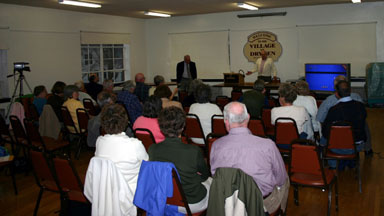
Walter Franklin discusses the earliest days of the TC3 idea.
Franklin said that while there were several colleges in the area - Cornell University, Ithaca College, and SUNY Cortland - there was a gap. The nearest community college was in Auburn, a long drive from Cortland. The Cortland group heard that Ithaca was also interested in similar things, though in Ithaca. When the two groups got together, meeting at Groton High School, they looked at formulas for support, but there hadn't been a multi-county college at that point. Smith-Corona especially encouraged them to move forward.
Space picked up the story again at this point, emphasizing the regional battles over the college. While the SUNY master plan encouraged joint projects between counties, that wasn't going to be easy. Tompkins County had twice the population and tax base of Cortland County, and Space said "the City wanted it for itself". There were multiple simultaneous conflicts - between the two counties and between the rural areas and the City of Ithaca within Tompkins County.
Space said that:
"I often feel that the City of Ithaca and the surrounding rural towns are quite different, although they are becoming a lot more similar now. The City of Ithaca prides itself on its own vision, inspiration, etcetera, and I often think that where the city boundaries end and the town begins is where reality begins. The study committee came to the agreement that it should be a two-county project, but there were those in the city especially that wanted it for themselves, and wanted it very strongly, and it showed itself in the final step that came up."
The State University of New York pushed hard for a two-county solution as well, wanting rural counties to get together. Because of its own division, Space said Tompkins County decided Cortland County should vote first, hoping that they might vote it down, so that "we can have it all for ourselves." The vote in Cortland County, in September 1966, was 19-2 in favor, and Tompkins had to vote the next week. The Tompkins County Board of Supervisors split 8-8, with town supervisors voting for and city representatives against. Helen Hoefer, a city representative, changed her vote, and it went through.
The college was approved, but that was hardly the end of the politics. Tompkins and Cortland counties both got to appoint two members to the Board of Trustees, and the governor appointed five members, three from Tompkins County and two from Cortland County. Ron Space was appointed to the board from Tompkins County with a nine-year term, the longest of the original staggered terms. He was the only board member who wasn't from the City of Ithaca or the City of Cortland.
Before the initial board meeting in September 1967, two of the Cortland appointees arrived at Space's house, unannounced, hoping he would consider running for the chairman's position. "I had to decide if I was egotistical enough to vote for myself," said Space, then the youngest of the members (at 36). Why?
"I've always lived in Tompkins County, but being a farmer, we were much more business-oriented toward Cortland County than we ever were to Tompkins County. And it just so happened that my wife... is a Cortland girl. They didn't want the chairman to be from the City of Ithaca. They didn't trust them, and felt it would be unfair."
Space had never met the trustees from Ithaca, but knew several of the trustees from Cortland. In the end, at the meeting, it was a 5-4 vote for "the farmer from McLean". Space was happy with the cooperation he had from the Tompkins County trustees, singling out Robert Sprole of Therm for his help. Helen Hoefer, whose vote made it possible, was also one of the trustees.
Now that the regional battles were largely settled, SUNY focused on getting the board to work together, controversially telling them to meet in private for their first few meetings, much to the fury of the Ithaca Journal. They forged a common vision, put in for a budget, and hired a president. After interviewing five of six candidates on a cold Saturday in January, the board was exhausted, but the sixth candidate, Hushang Bahar, woke them up again, and they hired him. Space described Bahar as "the kind of person you loved or hated, but boy did he make decisions... and if he made a wrong one, wow, would we hear about it."
The next step was finding an interim site. The Agway headquarters on South Hill was an option, but Agway couldn't provide enough room. There was a high school in Ithaca that was possible, but voters turned down funds for a new high school. Smith-Corona owned an old high school in the Village of Groton, though, and offered it to TC3. Smith-Corona gave it to the college, and the Groton school board forgave the mortgage they held on the building.
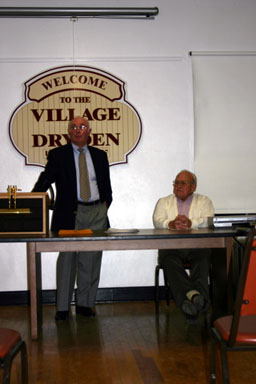
Ron Space talks about TC3's first building in Groton.
They also had to come up with a name. "South Central Community College" was considered, but the state encouraged "Tompkins Cortland Community College", and students came up with the TC3 abbreviation.
Opening the building meant clearing it out, reorganizing it, finding furniture (SUNY Cortland helped), and hiring faculty. With eight faculty and 150 students, the school opened in Fall 1968.
Now that the school was running, politics could return, as the board looked for a permanent site. It clearly couldn't be in Cortland or in Ithaca, and it had to have public water and sewer. Groton and Dryden were the most viable candidates, and the college asked the communities for proposals. Groton suggested an area on the southeast side of the village, while Dryden suggested both the current Yellow Barn commercial park (where the school board offices are, for now) and the current location of TC3.
The president of the First National Bank of Dryden bought the property, though Space didn't think he'd made anything on the deal. The proposal also considered building the parcel out to 500 acres (from 220) by buying two adjacent parcels. After much heavy lobbying, involving Space's next-door neighbor and college roommate/best man, the Dryden parcel won out, with about 470 points of a possible 500 in the evaluation to the Groton site's 300. Groton was further from Ithaca, which didn't help. The Tompkins County board approved the smaller version of the Dryden site, buying it for $70,000.
In 1974, the college opened a $14 million facility. The state paid half, and the counties were to contribute half, but the counties found $4.5 million in federal funds, and so only had to contribute $2.5 million, split 2-1 between Tompkins and Cortland counties.
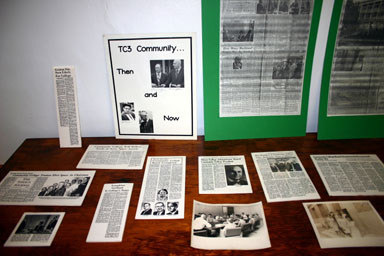
Part of the TC3 memorabilia display.
There were a few questions. Gina Prentiss asked about the growing number of students from outside the county. Space guessed that about 70% were still from the county, though also said that Tioga County provides a large number of students. Other counties with students attending make contributions that go to the capital fund of the college. Town Board member and TC3 Director of Information Technology Marty Christofferson noted that out-of-state residents pay double, and that the diversity is "great for the local students."
Someone asked if was a success, to which Walter Franklin said it went way beyond their hopes for the college. Lucille Baker, a professor at TC3, reminisced about the early days of the college when Hugh Bahar's charisma held them together, though faculty meetings were often in uproar, running late, with professors standing on tables. Space said that they sometimes kept Bahar from going to budget hearings and banging on tables.
The night concluded with a video on the college, opening with scenes from the Eight Square Schoolhouse and celebrating the rather different-looking new college. Rod Serling, more famous for The Twilight Zone, narrated, describing TC3 as a "hectic relaxed noisy quiet busy peaceful place... a flexible place in a flexible place."
(The Dryden Town Historical Society recorded the session on both audio and video, so if you'd like more information - this article is just a brief summary - contact them at 607-844-9209.)
This week's Courier
This week's Dryden Courier includes an article on Dryden Middle School's production of Fiddler on the Roof, which will be performed April 22nd through 24th at 7pm each night. On a similar note, the "Mind over Matters" column looks at a CD release party for beyondmeasure, Dryden High School's a cappella choir.
There's also an editorial on open government, noting the obligations governments have under New York's Open Meetings Law. It's well-worth a read, and next week's editorial will be covering the Freedom of Information Law. Those two laws make a lot of what you see here much easier, not to mention possible!
There's also a piece on NYSERDA, the program we used when doing our house's energy improvements last year.
Finally, Tony Hall profiles me and this site. Fortunately he doesn't give me any titles I have to live up to, and there are some nice comments from Kathy Zahler and Town Councilman Steve Stelick. The only glitch is that he says I've been here a year, when I've been here four. On the other hand, if I could change the date on the paper from 2004 to 2000 and read the same story today, I'd certainly have learned a lot more about how the town works in those four years than I know after about six months of this.
Update: Oops, missed one. There's also a piece on the Sustainability Salons, which I mentioned earlier. I've been going to the one in Lansing at Rogue's Harbor (map), which meets from 5:30pm to 7pm, Mondays through May 3. They caught me in the picture.
April 22, 2004
Green buildings, ICSD
Today's Ithaca Journal, taking note of Earth Day, takes a look at green building practices in Tompkins County, including the Tompkins County SPCA expansion building under construction on Hanshaw Road.
There's also a lot of coverage of the Ithaca City School District, with coverage of a press conference Superintendent Pastel held on continuing incidents of racial bias. They also cover its passing a budget with a 5.2% spending increase (for a likely tax levy increase of around 6%), though the Journal's editorial points out that all tax levies are tentative until the ever-delayed state budget is in place.
Finally, there's a guest column from J. David Ferris of Lansing on the county executive proposal that Republicans made back in December. This column has a very different tone from prior pieces on the subject, notably the guest column from John Marcham to which it responds.
With broad swipes like "our county legislative chair who was elected by the sum total of 524 votes in his district and does not have to worry about standing in front of the entire county electorate with his extreme political views", "I also think that the current board chair represents the most extreme left of the Democratic Party in this county," and "a similar campaign that I can only call 'Politics of Mass Distraction'", this column seems like a straightforward partisan charge for changing the the county's government, with relatively little interest in its supposed concern about the form of government.
This guest column reinforces my belief that the people pushing for this change see it as their last chance to put a Republican at the top of the county government rather than a Democrat. Given demographic trends in the county, I'm not sure they'd be happy with the results even if they got this change.
(I made a list of earlier Journal articles on the county executive proposal.)
Walrath announces run against Boehlert
It looks like there will be a Republican primary in the 24th Congressional District, which includes Dryden. The Auburn Citizen reports that Dr. David Walrath announced Tuesday that he will run for the Republican nomination, claiming that "my candidacy represents the Republican wing of the Republican party, whereas my opponent represents the John Kerry wing of the Republican party."
The 2002 primary between Walrath and incumbent Sherwood Boehlert was within 2700 votes, though Boehlert won the general election against Walrath by about 81,288 to 26,578.
Dryden School updates in the Shopper
The April 20th issue of The Shopper includes the Dryden Board Briefs for the April 12th meeting. (Unfortunately this brief doesn't appear to be posted yet, but hopefully that will change. Update: It's been fixed.) I noted this meeting's coverage in the Ithaca Journal, and the Board Briefs are much the same. One interesting piece that the briefs provide is attendance - apart from the board and superintendent, there were "9 District employees, 4 students, 11 community members, 2 members of the press."
There's also a notice that absentee ballots for the May 18th school board elections are available. To get one, apply to Linda Carr, the district clerk, at 844-5361 extension 225.
Two memorable houses
The houses on the western corners of the Mount Pleasant Road-Freese Road-Route 366 intersection are quite distinctive, though very different.
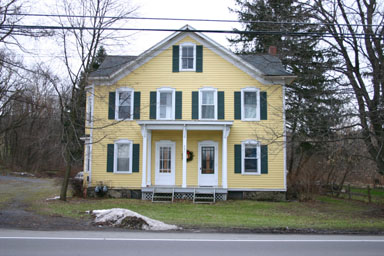
981 Dryden Road (map)
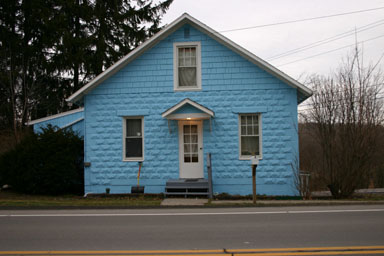
980 Dryden Road (map)
980 Dryden Road also seems to be the only house along 366 with a short stretch of sidewalk.
April 23, 2004
History and development
The news in today's Ithaca Journal is county news, not Dryden news. The Journal looks at "Creating a Competitive Workforce Advantage," a conference that was sponsored by Tompkins County Area Development, Tompkins Workforce New York, and the Tompkins County Chamber of Commerce. Consultant Edward Barlow told listeners that the broad context of life here makes a tremendous difference to the local workforce:
"Affordable housing, training workers, a livable wage, the educational pipeline -- it all needs to come together. It is important to recruit people but it is not just about jobs. It's also about lifestyle."
In other news, the DeWitt Historical Society is trying to improve the future for the past by changing its name to "The History Center in Tompkins County" and seeking more members. Update: They've changed their web site address as well, to http://www.thehistorycenter.net/.
Greater Varna
In an earlier entry, I calculated how many people lived in the Varna hamlet as defined by the Draft Comprehensive Plan. I was curious about how many people a larger picture of Varna might include, and so I came up with the following map:
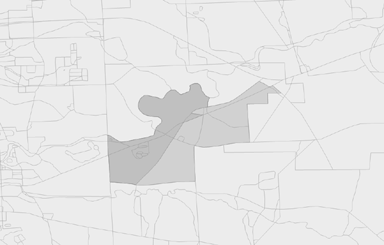
Census blocks which highlight the core hamlet of Varna and a possible larger interpretation of Varna.
In addition to the areas I used before as the "core" hamlet area, I've included blocks further east along Route 366, stopping at Baker Hill Road, as well as blocks between Route 366 and Stevenson Road along Turkey Hill Road. This is by no means a 'canonical' Varna, but it seems reasonable, especially for purposes of discussing development and traffic impacts.
The boundaries are certainly negotiable, but reflect my next project, which is to calculate populations for Ellis Hollow and Bethel Grove, so I've avoided some areas that are more commonly accessed from Ellis Hollow Creek Road. I also could have gone all the way to the 13/366 intersection, but stopped at Baker Hill Road. Adding that last block would add 14 people, 8 households, and 10 housing units to the total.
(It's also worth noting that while Observatory Circle is pictured on the map, the block surrounded by it reports zero population, so undoubtedly there's been some growth since the 2000 census surveys.)
| Population | Greater Varna | Core Varna |
| Total | 976 | 679 |
| White | 823 | 568 |
| Black | 22 | 14 |
| Native American/Eskimo | 8 | 8 |
| Asian | 76 | 56 |
| Hawaiian/Pacific Islander | 1 | 1 |
| Other | 10 | 7 |
| Multi-racial | 36 | 25 |
| Hispanic | 21 | 19 |
| Males | 450 | 306 |
| Females | 526 | 373 |
| Under 5 | 49 | 36 |
| 5 to 17 | 96 | 61 |
| 18 to 21 | 49 | 39 |
| 22 to 29 | 233 | 173 |
| 30 to 39 | 165 | 128 |
| 40 to 49 | 137 | 85 |
| 50 to 64 | 136 | 85 |
| 65 and up | 111 | 72 |
| Households | Greater Varna | Core Varna |
| Total Households | 507 | 368 |
| Household - 1 Male Only | 79 | 62 |
| Household - 1 Female Only | 134 | 111 |
| Married, Children | 57 | 37 |
| Married, No Children | 107 | 61 |
| Male Head of House, Child | 2 | 1 |
| Female Head of House, Child | 25 | 21 |
| Families | 205 | 130 |
And looking at housing, we get:
| Housing Units | Greater Varna | Core Varna |
| Total Housing Units | 537 | 385 |
| Vacant | 30 | 17 |
| Owner-Occupied | 258 | 174 |
| Renter-Occupied | 249 | 194 |
April 24, 2004
A quiet Saturday
This morning's Ithaca Journal is pretty quiet on Dryden. There's an article on a benefit for Lansing teenager Valerie Glass at the Dryden Veterans Memorial Home tomorrow from 2-6pm.
There's also an article on what this week's change from the DeWitt Historical Society to the The History Center in Tompkins County will mean.
Speaking of history, I'll be the docent at the Dryden Historical Society (map) today from 10am-2pm. Stop by and see the exhibits!
April 25, 2004
More houses people drive by
Just west of the houses on the Mt.Pleasant/Freese Road corner are these three houses.
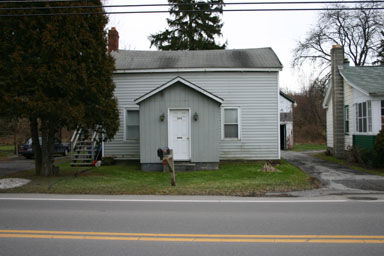
979 Dryden Road (map)
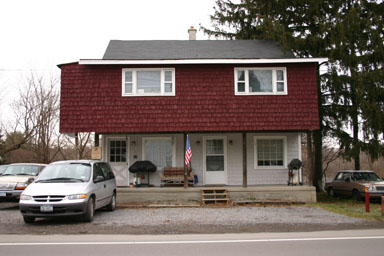
978 Dryden Road (map)
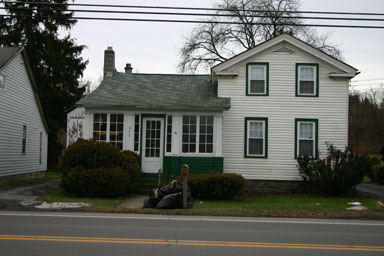
977 Dryden Road (map)
The Village of Dryden around the Civil War
The period right before and during the Civil War seems to have been a good moment for the Village of Dryden, if not a great a time for the country in general. George Goodrich looked at development in the area around the time of the village's incorporation. (Discussion of the Civil War itself is in other sections of the book.)
Chapter XXV.
Dryden Village in the War Period.
While the town and rural districts have been declining in population ever since 1836, the village of Dryden has had a slow but steady and continuous growth from the beginning of its settlement. Perhaps, however, at no time was that growth so rapid as at the commencement of this period. The building of the stone Woolen Mill by A. L. Bushnell at this time afforded a promise of future buisiness prosperity to the village, but if its somewhat checkered career, involving at least two failures, and two fires, in one of which all of the combustible material was destroyed, could have been foreseen, the high hopes based upon its success would have vanished. Still in its periods of prosperity is has been a source of great advantage to the village, giving employment to a considerable number of inhabitants, and at no time has it been capable of yielding products of so much value as at present.
The building of the stone block in 1852-3 by Jeremiah W. Dwight was a great undertaking for a young business man in a small village, but under his efficient direction and management it has always been a success, affording a good and continuous income from the investment.
At about the same time P. M. Blodgett built next west of the stone block the three-story wooden building known as the Blodgett block, which was not so successful, and which was destroyed by fire about 1866. Stimulated by these improvements, Col. Lewis Barton, who kept the old hotel opposite the stone block, enlarged it by adding a third story at this time, (1855.)
Col. Barton was a very popular landlord and a public spirited citizen, serving as president of the village in 1860, and as marshal on various occasions, one of which was a large temperance parade. He came to Dryden from Virgil early in this period and did in 1863. Among his descendants were Lieutenant Daniel W. Barton, who was killed in the battle of Spottsylvania, May 12, '64; Chas. W. Barton, whose surviving son, Daniel W., resides at Elisabeth, N. J.; Mrs. Mary E. Hiles, whose surviving son was recent engaged here in tracing out the annals of the Hiles family, and Lucy Ette Spiece, of Ardmore, Pa., who is now the only surviving child of Col. Lewis Barton.
The first newspaper published in the village came from the handpress of H. D. Rumsey, in 1856, and was first known as "Rumsey's Companion." After several changes in name and ownership it was discontinued, within two years after it commenced publication. It had, however, fortunately for us, published and thus preserved under the title of the "Old Man in the Clouds," the series of articles which have been of great aid in the preservation of the early history of Dryden. In July, 1858, it was revived under the name of "The Dryden Weekly News," by Asahel Clapp, who continued its publication successfully until 1871, when he removed it to Ithaca where it is still published by his son as The Weekly Ithacan. Soon after, a new paper was published at Dryden village under the name of The Dryden Herald, which, after changing hands several times, was greatly enlarged and improved under the management and ownership of A. M. Ford and now under the proprietorship of his son, J. Giles Ford, is one of the most enterprising local papers to be found issued in a country village.
The war itself left but very little impress upon the village, and, as already stated in the town history, it was from a business point of view a time of unusual prosperity.
The advent of the Southern Central railroad in 1869 has already been referred to and produced no great immediate change in the affairs of the village. To the merchants the advantage of reduced freight rates and quicker transportation was offset by the ease and frequency with which their customers sought places in larger towns to do their trading. To the farmers, because it offered a better and nearer market, especially for such bulky articles of produce as potatoes and hay, the permanent benefit of the railroad has been considerable, and without railroad facilities to-day our condition would be deplorable. A proposition was made when the Ithaca & Cortland railroad was being built that by raising the sum of twenty-five thousand dollars, the junction could be secured within the limits of Dryden village, and at almost any other time it would have been seriously entertained, but at this time, the village had almost exhausted itself in the effort to secure the Southern Central, and affected with the reaction already being experienced from the decline of the unusual prosperity of the preceding years, the people were content to let the opportunity pass by.
The merchants of this period included J. W. Dwight & Co., (the company including E. S. Farnham, Isaac P. Ferguson, and A. F. Tanner) in the stone block, George L. Truesdell and William H. Sears, in the Exchange block, and Hiram W. Sears, Eli A. Spear, and later Merrit Baucus, in the brick block. Hiram W. Sears, who married a daughter of John Southworth, for a number of years carried on an extensive business in packing pork, buying wool, and other mercantile enterprises.
Cyrus French developed a flourishing business in the hardware block. G. H. Sperry and Alanson Burlingame inaugurated the coal and lime business at the railroad station. H. F. Pierce conducted a moderate furnite and undertaking business, while Harrison Marvin and Otis Murdock conducted the boot and shoe business.
The Woolen Mill flourished in the hands of E. Rockwell, the tannery was greatly enlarged and improved by the Kennedy Brothers, and the grist-mill was managed by John Perrigo, assisted later by his son, Charles M.
The medical profession was reinforced during this time by the arrival of Dr. Wm. Fitch, from Virgil; and Dr. J. J. Montgomery succeeded to the practice of his father.
The old hotel passed from the proprietorship of Col. Lewis Barton to Deuel & Jagger, then to Jagger alone, and afterwards into the hands of Peter Mineah, whose co-partner at one time in the business was Ex-Sheriff John D. Benton, while James H. Cole developed the Grove Hotel after the Blodgett House was destroyed by fire. Mills Van Valkenburgh, Garry E. Chambers, W. W. Hare and Silas S. Montgomery developed into lawyers from law students in the office of Milo Goodrich.
A literary society, sometimes in the form of a reading circle and at others as a debating club, flourished in these days and many of the older citizens will remember with what earnestness and zeal Dr. Briggs, J. W. Dwight, T. J. McElheny, John C. Lacy, and many others maintained the affirmative or the negaive of numerous questions in debate at the old school house. Our attention has recently been called by one of the old members of this literary organization, to the beneficial results which were seen in the subsequent careers of some of its members, and a little reflection should awaken in us of the present generation an appreciation of such means of self-culture.
In the year 1857 Dryden village was incorporatied, the population then being about four hundred and the corporate limits including 999 1/4 acres. The petition for incorporation was signed by Thomas J. McElheny, Isaac P. Ferguson, George Schenck, Lewis Barton, Freeman Stebbins, Hiram W. Sears, William W. Tanner, David J. Baker, N. L. Bates, Abraham Tanner, Jeremiah W. Dwight and fifty-eight others, and upon the vote taken upon the question of incorporation one hundred and twelve ballots were cast, of which seventy-eight were in the affirmative. In 1865 the village was re-incorporated under a special charter (chapter 320 of the laws of 1865) prepared with great care by Mills Van Valkenburgh, then an attorney residing the village and afterward county judge.
The first officers elected in 1857 were as follows: Trustees, David P. Goodhue, Rochester Marsh, William W. Tanner, John B. Sweetland, and Isaac H. Ford; assessors, Augustus H. Phillips, Orrin W. Wheeler, and John C. Lacy; collector and poundmaster, Godfrey Sharp; treasurer, Horace G. Fitts; clerk, Thomas J. McElheny.
The following table gives the names of the presidents and clerks of the village to the present time:
| PRESIDENTS. | |||
|---|---|---|---|
| David P. Goodhue, | 1857-8 | Harrison Marvin, | 1876 |
| Freeman Stebbins, | 1859 | George E. Goodrich, | 1877 |
| Lewis Barton, | 1860 | J. E. McElheny, | 1878 |
| Freeman Stebbins, | 1861 | John H. Pratt, | 1879-80 |
| John C. Lacy, | 1862 | John H. Kennedy, | 1881 |
| John Perrigo, | 1863 | Erastus H. Lord, | 1882-3 |
| John W. Phillips, | 1864 | D. R. Montgomery, | 1884-5 |
| Rochester Marsh, | 1865-6 | Albert J. Baker, | 1886 |
| Eli A. Spear, | 1867 | John H. Kennedy, | 1887-8 |
| D. Bartholomew, | 1868 | D. R. Montgomery, | 1889-90 |
| G. H. Washburn, | 1869 | George E. Goodrich, | 1891-4 |
| Alvin Cole, | 1870 | C. D. Williams, | 1895 |
| John H. Kennedy, | 1871-2 | George Sutfin, | 1896 |
| Rochester Marsh, | 1873 | E. Davis Allen, | 1897 |
| G. H. Sperry, | 1874-5 | ||
| CLERKS. | |||
|---|---|---|---|
| T. J. McElheny, | 1857 | S. S. Montgomery, | 1867 |
| M. Van Valkenburgh, | 1858 | C. D. Bouton, | 1868 |
| Harrison Marvin, | 1859 | S. S. Montgomery, | 1869-70 |
| William H. Sears, | 1860 | George E. Goodrich, | 1871-2 |
| I. P. Ferguson, | 1861 | William E. Osmun, | 1873-5 |
| Mott L. Spear, | 1862 | George E. Goodrich, | 1876 |
| William H. Sears, | 1863-4 | W. H. Goodwin, Jr., | 1877-80 |
| C. D. Bouton, | 1865 | L. D. Mallery, | 1881-2 |
| M. Van Valkenburgh, | 1865 | D. T. Wheeler, | 1883-94 |
| William H. Sears, | 1866 | E. D. Branch, | 1895-7 |
Goodrich, George B. The Centennial History of the Town of Dryden, 1797-1897. Dryden: Dryden Herald Steam Printing House, 1898. Reprinted 1993 by the Dryden Historical Society. Pages 94-8.
(The Dryden Historical Society, which sells this book, may be reached at 607-844-9209.)
Populations for Ellis Hollow and Bethel Grove
After the Greater Varna calculations, I thought I'd take a look at Ellis Hollow, Bethel Grove, and Snyder Hill. Unfortunately, the U.S. Census Bureau uses Snyder Hill Road as a dividing line between blocks that front Ellis Hollow Road and blocks that front Route 79, Slaterville Road, so I can't calculate Snyder Hill separately.
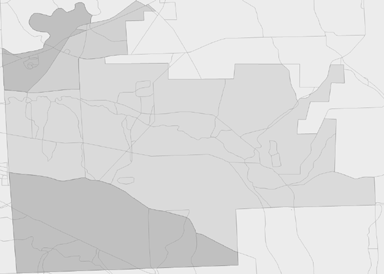
Ellis Hollow and Bethel Grove census blocks, with Varna to the north.
These figures are only for the portion of Bethel Grove that is actually inside the Town of Dryden, though there is development on both the Ithaca and Caroline sides along Route 79. Ellis Hollow includes Ellis Hollow Road, Ellis Hollow Creek Road, and roads that come off of those. Snyder Hill is divided among the two areas, with the north side of Snyder Hill Road going to Ellis Hollow and south side going to Bethel Grove. As usual, all figures come from the 2000 census data.
| Population | Ellis Hollow | Bethel Grove |
| Total | 1574 | 581 |
| White | 1500 | 553 |
| Black | 19 | 9 |
| Native American/Eskimo | 4 | 0 |
| Asian | 37 | 7 |
| Hawaiian/Pacific Islander | 0 | 0 |
| Other | 8 | 4 |
| Multi-racial | 6 | 8 |
| Hispanic | 33 | 6 |
| Males | 755 | 266 |
| Females | 819 | 315 |
| Under 5 | 85 | 42 |
| 5 to 17 | 286 | 89 |
| 18 to 21 | 61 | 22 |
| 22 to 29 | 122 | 57 |
| 30 to 39 | 187 | 114 |
| 40 to 49 | 300 | 91 |
| 50 to 64 | 348 | 101 |
| 65 and up | 185 | 65 |
| Households | Ellis Hollow | Bethel Grove |
| Total Households | 643 | 260 |
| Household - 1 Male Only | 56 | 34 |
| Household - 1 Female Only | 98 | 49 |
| Married, Children | 178 | 53 |
| Married, No Children | 225 | 60 |
| Male Head of House, Child | 7 | 3 |
| Female Head of House, Child | 18 | 17 |
| Families | 444 | 147 |
And looking at housing, we get:
| Housing Units | Ellis Hollow | Bethel Grove |
| Total Housing Units | 670 | 283 |
| Vacant | 27 | 23 |
| Owner-Occupied | 517 | 171 |
| Renter-Occupied | 126 | 89 |
April 26, 2004
Dryden benefit raises $2700 for Lansing teen; environment thoughts
This morning's Ithaca Journal reports on the success of yesterday's country dance benefit for Lansing teen Valerie Glass, held at the Dryden Veterans Memorial Home.
An article on Earth Day quotes Dryden nine-year-old Gabriel Banford.
Finally, there's a guest column on designing communities around people's needs, not cars' needs, which is part of the Sustainable Tompkins project. Their nightly salons include one in Lansing at Rogues' Harbor, which I've been attending, and a few other Dryden folks have been there as well. Tonight's session, from 5:30pm to 7pm, is on "Designing Sustainable Communities". (I reported earlier on the first meeting.)
Draft County Comprehensive Plan available
If the Town of Dryden Draft Comprehensive Plan wasn't enough planning excitement for you, you can now add the Tompkins County Comprehensive Plan to your reading list.
I haven't had a chance to read it, but I'll be looking it over and writing more soon. Also, on April 29, the Tompkins County Planning Department will be holding an open house from 3pm to 7pm and a public meeting from 7pm to 8pm at Dryden Town Hall (map).
Busy day at Freese Road bridge
There was a lot going on at the closed Freese Road bridge today, with NYSEG doing electrical work to support the replacement sewer pump on the south side of the bridge, and Tompkins County working on the north side of the bridge.
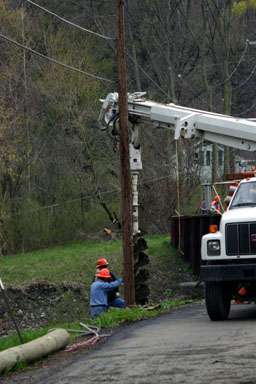
Electrical work at Freese Road bridge
The sewer pump also had a new panel, a change from my last visit.
April 27, 2004
Dryden resident running for ICSD; county news
Today's Ithaca Journal reports that a Town of Dryden resident, David R. Lee, was the first to file petitions for a school board campaign in the Ithaca City School District.
The rest of the Dryden-relevant news in today's paper seems to be county news. There's a piece on the Budget Community Advisory Council's initial recommendations to the county for ways to change the budget process and save money. I wish the article was a little clearer about what this committee was and who is on it - all I can glean from the article is that it has eleven members, including John L. Neuman, CEO of eCornell.
There's also news of how to get a free ride on TCAT tomorrow, thanks to a coupon in this brochure (191 KB PDF). The coupon is only good on April 28, 2004, and is part of Curb Your Car Days.
Finally, the editorial examines last week's "Tompkins County: State of the Workforce" report, and discusses ways to build a more attractive workforce here. I'm not sure if the editorial is referring to a more updated document, but I did find a Tompkins County State of the Workforce 2003 (212 KB PDF) report.
Mysterious markers
The other day I noticed concrete markers along the south side of Route 13. I'd driven by them for years without seeing them, but suddenly they seemed to be everywhere.
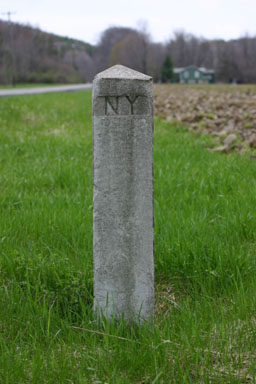
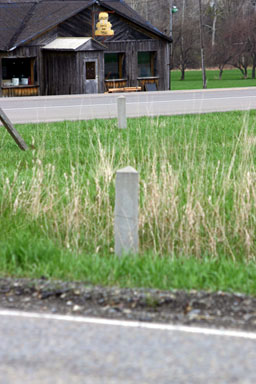
Monuments at Ringwood Road and Route 13
The survey map for my own house includes one of these, though the marker is in my neighbor's property by a few feet.
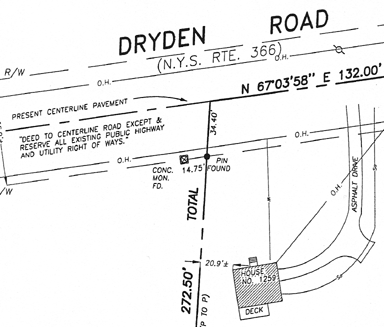
Survey map, 1259 Dryden Road.
Based on this map, my guess is that the monuments indicate the southern edge of the right-of-way for the highway. I'm still not positive of that, though, because there are places where groups of markers (like those at Ringwood Road) appear. These markers aren't just indicating the edge of the highway.
Another possibility is that the monuments indicate tax map boundaries, as my property is in the corner of a tax map section, but the highway seems more likely. If you have an explanation, please leave it in the comments!
Cortland Road Sewer District complexities
[Note: I wrote this last week but held it for documents I'd requested from the Town under the Freedom of Information Law (FOIL). Most of those are now enclosed, but there's one document here which the Town didn't have, and I only requested it from the Village today. It doesn't make sense to hold up the story further, so I'll update it with that extra document when I get it. Update: It's there now.]
Nearly two hours of intense discussion about the Cortland Road Sewer District between the Town of Dryden and Village of Dryden boards Wednesday produced a list of issues to resolve and a few conversational highlights.
The contract for the Cortland Road Sewer District apparently expired in 2002, though it was worded vaguely enough that the expiration wasn't clear. The Town Board took steps at their last meeting to make billing in the Cortland Road Sewer District more like the billing in the Village, based on usage, removing one issue.
Most members of the Village and Town Boards were there, but the attorneys were not; the hope was that the two groups could decide on the content that needed to go into a new agreement and then have the attorneys draft language reflecting that agreement. The conversation started with a proposed new agreement (541KB PDF) and copies of the old agreement (573 KB PDF), though there were concerns about how to tell what had changed. Jon Bradley, Village of Dryden Public Works Superintendent, said that too much had changed structurally for redlining to be easy. Town Councilman Chris Michaels still hoped to make it work.
Mayor Reba Taylor of Dryden also had a list of almost half a million dollars of work the Village had done and never charged back to the Town (37KB PDF), though that may now be "water under the bridge".
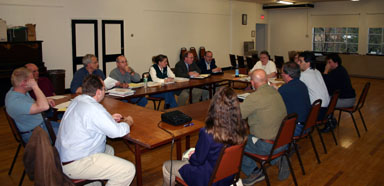
Village Mayor Reba Taylor speaks to the joint meeting
The biggest issues seemed to be the nature of costs in supporting the district and how best to distribute them. The Town's users pay both a usage fee (at 1.25 times the Village rate) and a water district tax, while Village users pay only a usage fee.
The costs of the system affect the two parties in a variety of ways. The Village has borne most of the burden in identifying problems in the system and frequently helps out - Mayor Taylor brought up how the old Dunkin' Donuts (now Todi's Pizzeria) used to "lift manhole covers with the grease in their lines", and the Village's greater ability to collect and analyze data about the performance of the system came up frequently. The Village also has primary responsibility for operating and maintaining the sewage treatment plant. The Town has been responsible for its own lines, but limited capacity on the Village lines means that the Village may be asking the Town to build separate "interceptor" lines to carry sewage to the treatment plant more directly.
Superintendent Bradley felt that the Village's provision of services to the Town was costing the Village a lot of money. He said that when "I heard Supervisor Varvayanis's proposal [for the Town to build its own sewer plant], I shouted for joy... the Village can get by with a lot less sewer plant without the Town, since there's not that much more to develop." If the Town built its own plant, that would cost the Town much more, but remove a lot of the strain on the Village.
One of the most complicating factors, brought up by Mayor Taylor at the start of the meeting, but never addressed in depth, was the amount of development the Town is planning to permit or encourage around the Village, and how much additional load that would place on the Village's sewer system. The future land use map (301KB PDF) in the Town's Draft Comprehensive Plan shows a lot of suburban residential development in areas just outside the Village. While there is some discussion of cost for water and sewer services on page 76 of the draft plan, the Village's current assessment of upgrades to their plant are vastly complicated by uncertainty about how much capacity they'll need in the future.
Another complication, though a problem in the present rather than in the future, is the unclear position of two of the biggest users in the sewer district - Dryden Middle and High Schools, and Tompkins-Cortland Community College. The original contract with the schools (477 KB PDF), which was with the Village and became the Town's reponsibility when the Cortland Road Sewer District was formed, is long since expired. TC3 presents particular problems, as its lines seem to be the culprit for massive infiltration when it rains, forcing the sewage plant to support much higher peak capacity than it should.
After much circling around and through these issues, Councilman Michaels proposed a summary of steps needed to move forward. The first - adjusting the terms of the Town sewer district to match those of the Village more closely, was already done. The remaining steps include:
- Updating the ordinances for the sewer district to better handle a variety of concerns raised;
- Stopping the infiltration problems flooding the plant with water;
- Assigning responsibility for monitoring the system and identifying problems;
- Assigning responsibility for fixing problems and enforcing rules for the system's use;
- Sorting out who pays for pipes the Town uses through the Village and how.
Councilman Mike Hattery suggested that updating the contracts between the Town and its largest users - TC3 and the schools - was also a concern, though Michaels suggested it could be addressed by ordinance. There were also questions about what might happen to all of these costs if the Village annexed the sewer district or parts of it, and how costs in the Town should be shared by new districts and the existing district if new sewer districts relying on the Village's treatment plant are formed.
While Michaels concluded optimistically by saying that "we have a lot of work to do, but we're not so far apart", it's clear that there are an enormous number of issues to work out to build a coherent and workable contract.
One of the Town's consultants, Chuck Franzese of Hunt Engineers, provided some concrete evidence that resolving this issues is possible, citing his own experience as a Councilman in the Town of Dix, in Schuyler County. Dix had to iron out a lot of issues to connect its sewer district (which includes Watkins Glen International racetrack) with the Village of Watkins Glen. It didn't sound easy, but it did, in the end, get accomplished.
April 28, 2004
beyondmeasure, Grange recognition, more
Since the Ithaca Journal instituted the Our Towns section, Wednesdays have consistently been a busy day for Dryden news. Today's paper includes:
- a story on beyondmeasure, the Dryden High School a cappella group that recently recorded a CD (and recorded it at Masterview Soundcrafts, along Route 13 in Dryden);
- Cathy Wakeman's Dryden Town Talk, which looks at honors the Dryden Grange gave Marilyn Brooks and Tom Miller last week, as well as a quilt presented by "Mary Ellen Rumsey and Sue Cardwell on behalf of 'folks who want to contribute to the annual Dryden Dairy Days, but who are not part of the Grange or the farming community'";
- and news of absentee ballots for Dryden Central School District elections and Dairy Day organizers seeking volunteers. Elections are May 18, while Dairy Day is June 12.
In county news, legislators have agreed to aim for a 3% tax levy increase, though they haven't agreed where to make the cuts that limited increase will require.
More houses in Varna
Continuing west from the last few houses, these houses are next.
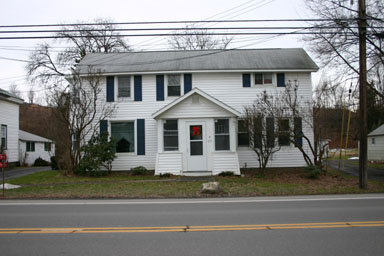
975 Dryden Road (map)
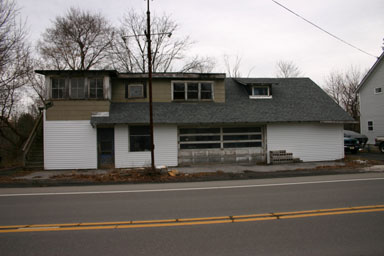
974 (or 976?) Dryden Road (map)
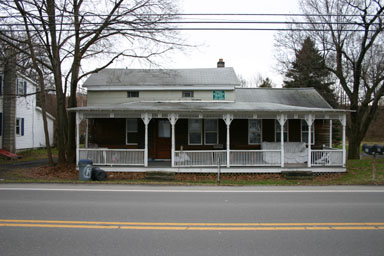
973 Dryden Road (map)
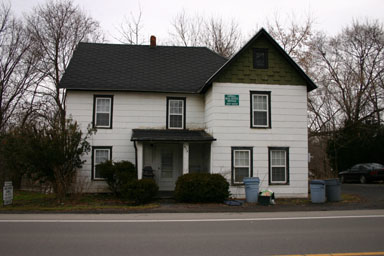
972 Dryden Road (map)
As mentioned in an earlier story, the last two of these houses have been for sale. I think I saw a SOLD sign on one, but I'm not sure. Also, the building I have listed as 974 may be 976; there's nothing to indicate which address it has, and it seems to be empty.
Elementary principal retiring, open houses
I try to write my coverage of the Ithaca Journal in the morning before the workday starts, but apparently today I wasn't too awake when I did it.
In addition to the stories I mentioned earlier, they also report that Paula Thoma, principal of Freeville and Cassavant elementary schools, has given notice that she will retire in 2007. The article also discusses the board's work narrowing down their choices for a new superintendent to six applicants from the current pool of seventeen. (There were thirty-three to start with.)
The print version of the Our Towns section also includes data on the number of households per resident in the Village of Dryden. Three-quarters of households have one car or two cars, but I'm impressed that almost 11% of residents have no car at all.
Also in the print version but not online are a Community Agency section on Head Start and a Community Calendar that includes three open houses:
- Tompkins Community Action Early Childhood Department Head Start, tomorrow, April 29th, from 4-7pm at the TC3 farmhouse, 168 North Street (map)
- Tompkins County Comprehensive Plan Open House and Public Meeting Draft Plan Review - tomorrow, April 29th, from 3-7pm, with a meeting a 7pm, at the Dryden Town Hall, 65 East Main Street (map)
- TC3 Open House - Friday, April 30th, from 11am to 1:30pm.
Softball, scrap metal cleanup, and chipping
This week's issue of The Shopper includes three handy notices from the Town of Dryden:
- The Recreation Department has a notice about registration for the Duke Erickson Adult Co-ed Softball League. There are two leagues (Tuesday and Saturday). Team roster forms are available at Dryden Town Hall (map) and must be submitted by May 15th. Players must be men or women sixteen or older.
- There will be a scrap metal cleanup with a dumpster at the Dryden Highway Department (map). They'll take scrap metal from May 3rd to May 30th, Monday through Thursday 7am-2pm and Fridays 7am-11am.
- The Town will also be having a chipping day on May 8th, rain or shine from 8am to 4pm. Twigs and small branches will be accepted at a Johnson Road site (map). The notice says to "bring your own containers if you want to take chips with you."
There's also a notice for the Freeville PTA Carnival, which will be Saturday, May 1st at Freeville Elementary School (map) from 11am to 3pm.
April 29, 2004
Two Dryden residents leaving ICSD board, one running
This morning's Ithaca Journal reports that six people are running for three seats on the Ithaca City School District Board of Education. None of the three incumbents, including Dryden residents Arthur Berkey and Henry Kramer, is running again, while Dryden resident David Lee is running.
The district also voted to add a reading specialist if insurance fees drop enough to permit it.
In other Dryden news, the Freese Road bridge, which has seen lots of recent activity, will be closed another week, to May 6.
In county news, there's a report on Tompkins County Area Development's work on attracting high-tech businesses and encouraging affordable housing as well as a story on County Legislator Michael Koplinka-Loehr's plan to swim the length of Cayuga Lake to raise money for the Tompkins County Quality of Life Fund.
Grange honors, Dryden school renovations lead Courier
The front page of this week's Dryden Courier has a picture of the Dryden Middle School production of Fiddler on the Roof. The lead stories focus on the Dryden Grange's honoring of farmer and school board member Tom Miller and Red Cross volunteer Marylyn Brooks, as well as the Dryden School Board's effort to 'resurrect' improvements for music classes at the high school.
Inside, there's a story on Cassavant Elementary School's work on a project about stories of people who immigrated to the area, and an editorial on New York's Freedom of Information Law, a key tool for making this site work. There are also announcements of some events this weekend:
- There will be a New England Contra and Square Dance tomorrow, April 30, from 8pm to 11pm at the Bethel Grove Community Center, 1825 Slaterville Road (map).
- On Saturday, May 1, there will be a Jazz Dessert Night at Dryden Middle School gym, featuring the a cappella groups beyondmeasure and Dryden Voices. Tickets are $7.
There's also a article on Groton's efforts to turn a house over to Better Housing of Tompkins County for renovation, which seems an example worth learning from.
Living wage discussion in Dryden Tuesday night
Martha Ferger writes (and the Dryden Courier also reports):
Town of Dryden residents who support a higher minimum wage for New York State are invited to meet on Tuesday, May 4 at 7:30 pm at the home of Martha and John Ferger, 10 Union Street, Dryden (map).
Carl Feuer, an organizer for the Tompkins County Living Wage Coalition, will lead a discussion on ways we can help pass legislation currently before the NYS Senate that would raise the minimum to $7.10 hour. A recent study from the Fiscal Policy Institute in Albany found no evidence that a minimum wage higher than the current $5.15 per hour caused job loss and unemployment. On the contrary, between 1998 and 2001 the number of small employer establishments grew significantly faster in states with a higher minimum wage than in those with a lower minimum.
April 30, 2004
News near Dryden
This morning's Ithaca Journal has two stories one intersection west of Dryden, including an accident at the Sapsucker Woods-Route 13-Brown Road intersection that backed traffic into Dryden and a celebration of a one-lane bridge's 100th anniversary in Forest Home.
(Anyone know how old the Freese Road bridge currently under repair is?)
A guest column lists resources for seniors in Tompkins County.
Varna BBQ tomorrow
I'll be barbecuing chicken along with a lot of other people tomorrow, May 1st, at the Great May Chicken Barbecue at the Varna Community Center (map).
$6.50 for adults, $5.50 for seniors, or $3.50 for children under 12 gets a meal including a barbecued chicken half, baked beans, salt potatoes, cole slaw, roll and dessert. $3.75 buys half a chicken only. You can have your food eat-in or take-out.
(I'm still working on an events calendar, but if you have an event you'd like listed here, please contact me with details.)
School grades, expenditures
The print edition of today's Ithaca Journal contains a "Grading Our Schools" supplement which lists test results for schools and school districts in the area, including Dryden, Ithaca, and many more. It also lists spending per pupil for the 2000-2001 years (which is odd, given that the test results are for 2002-3). For comparison, here are the expenditures per student for all the districts listed:
| District | Expenditure per Student |
|---|---|
| South Seneca | $13,865 |
| Ithaca | $12,742 |
| Lansing | $12,577 |
| State average | $12,265 |
| Southern Cayuga | $11,502 |
| Dryden | $11,463 |
| Newfield | $11,460 |
| Moravia | $11,342 |
| Trumansburg | $11,050 |
| Groton | $10,909 |
| Newark Valley | $10,877 |
| Candor | $10,874 |
| Cortland | $10,854 |
| Spencer-Van Etten | $9,986 |
| Homer | $9,210 |
This is about 1% of the data provided in that booklet, which is a huge information overload if you try to look at everything at once. While total expenditure is not the right way to compare school districts, it's the easiest piece to extract from this for a blog entry. I strongly encourage you to pick up the Journal today or visit the New York State Department of Education's data.
